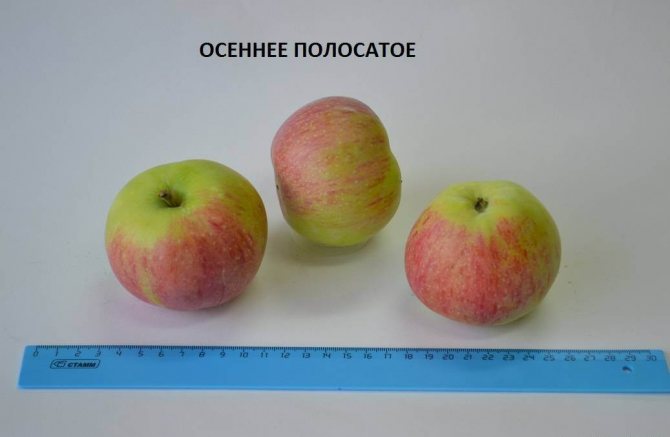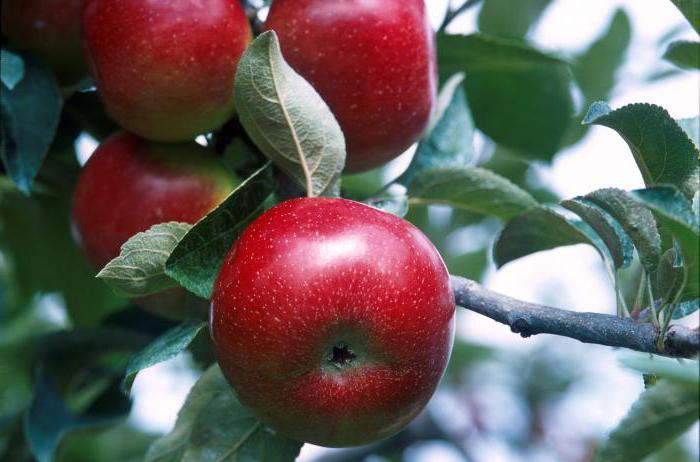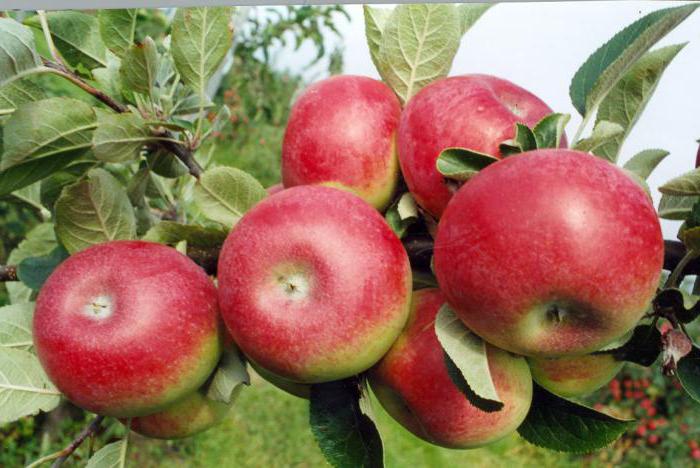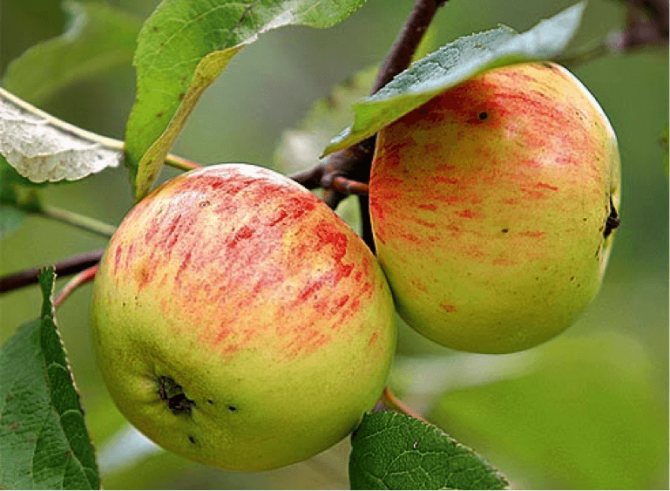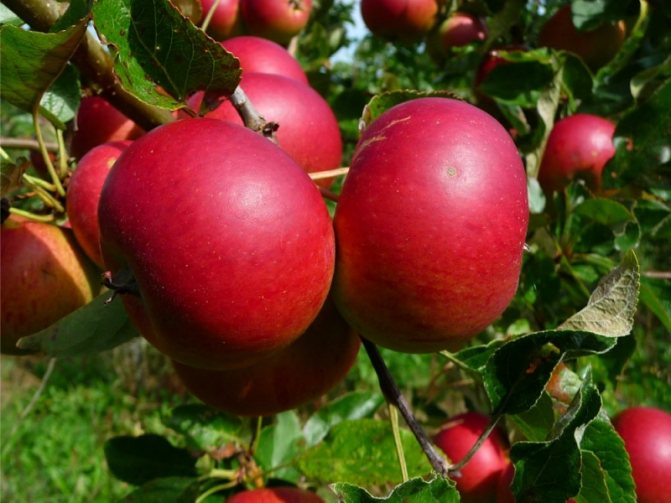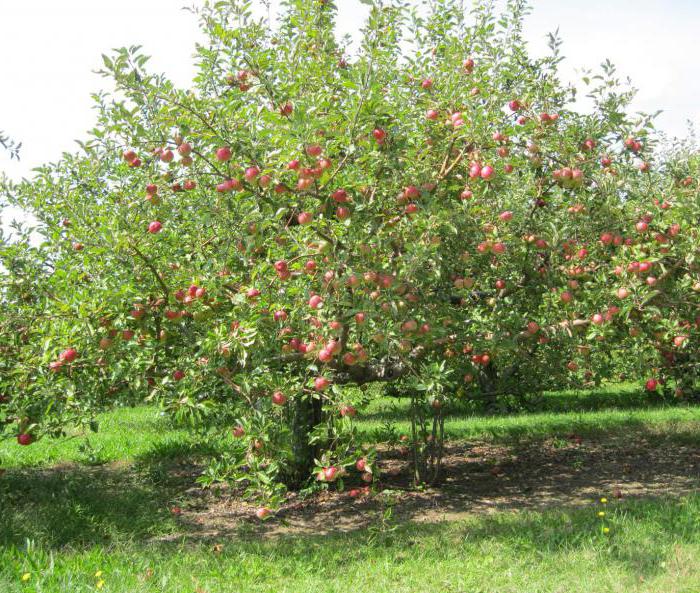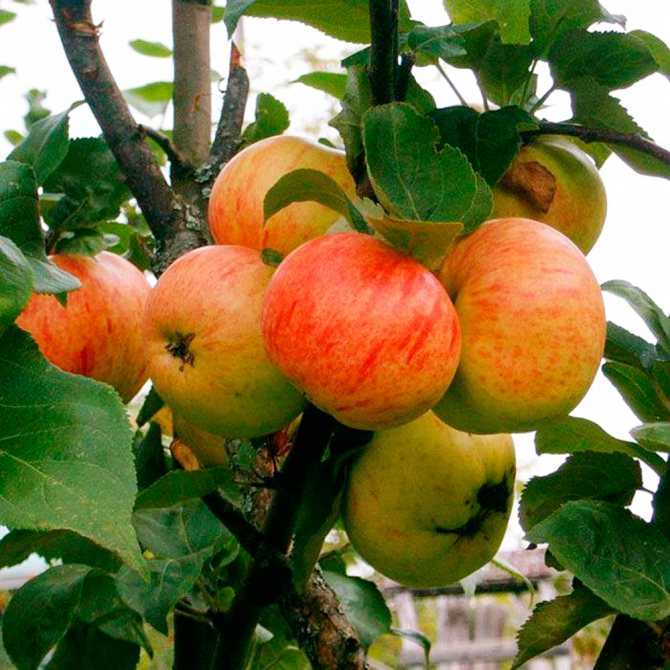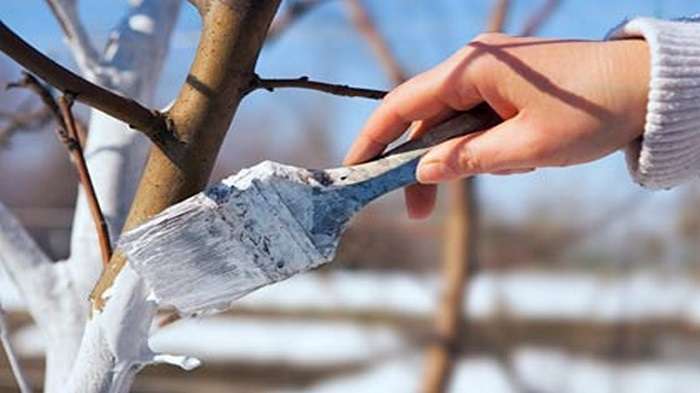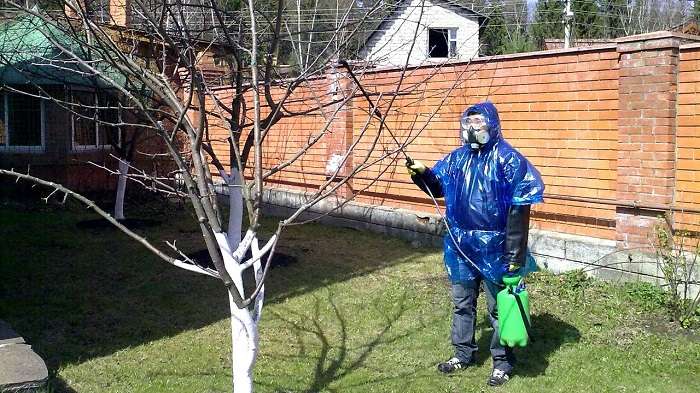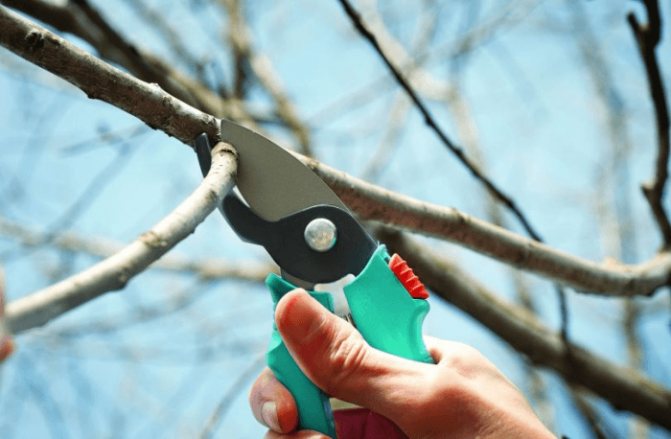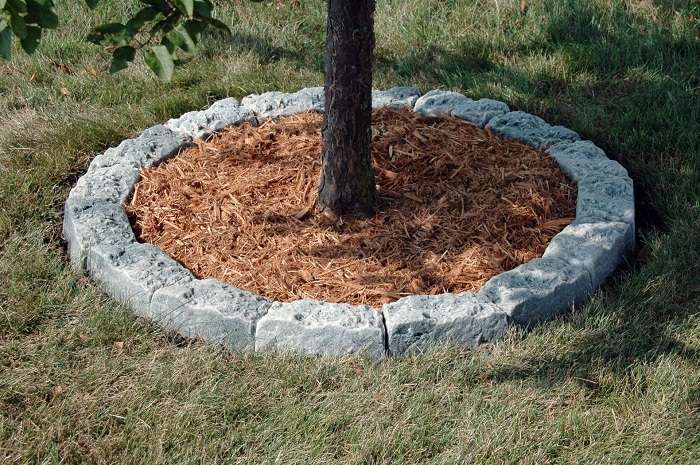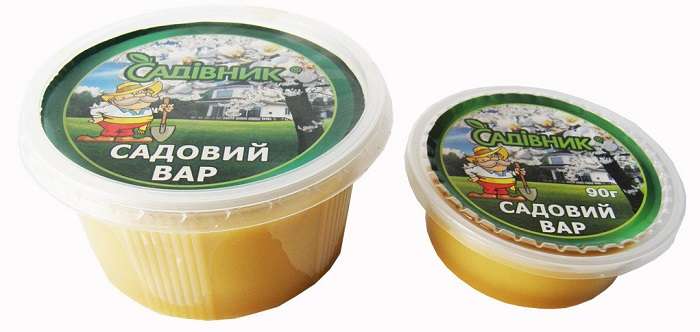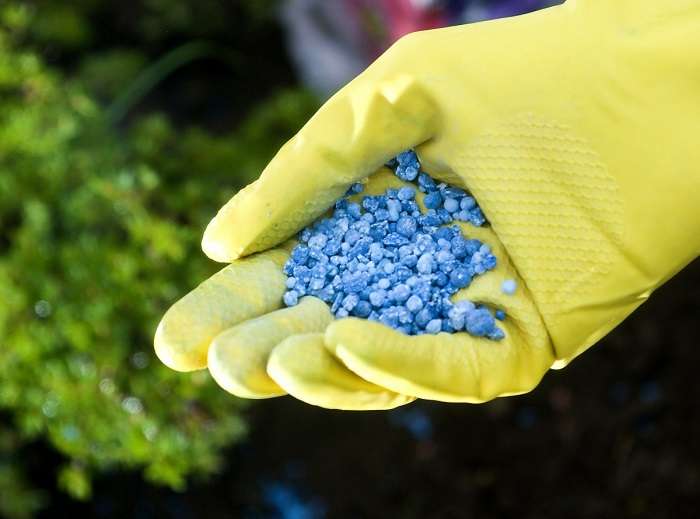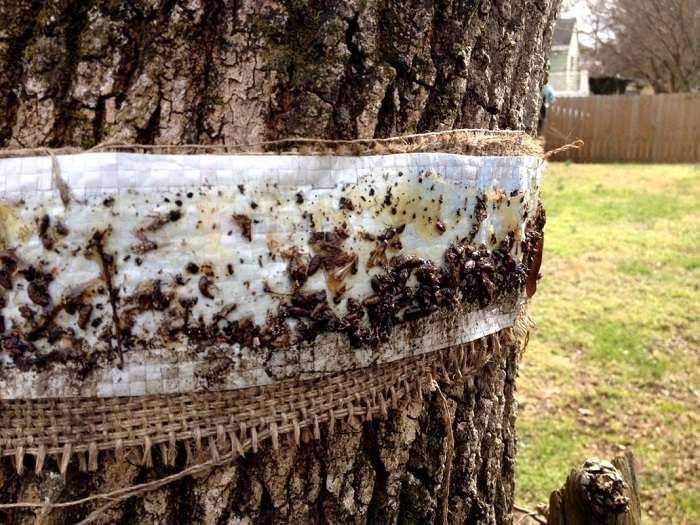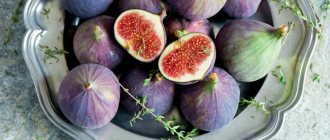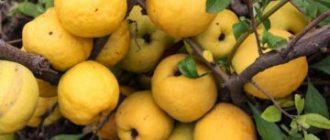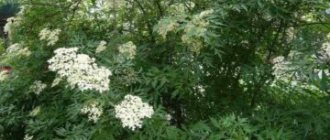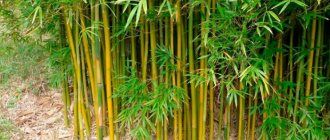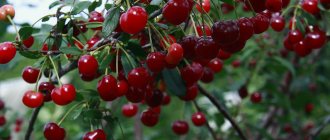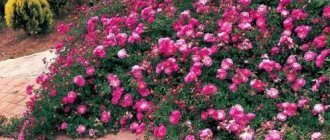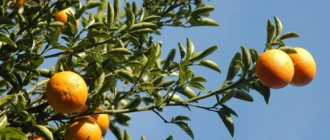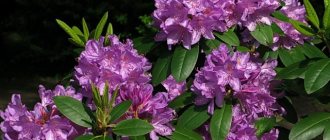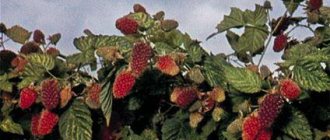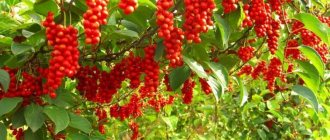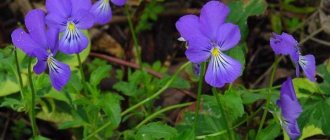The apple tree in our gardens is considered the most popular fruit crop. It is ahead of the distribution of cherries and pears, and its fruits are stored much longer than other trees in the garden, so the gardener begins to take care of the apple in the spring first of all. Apple trees, especially if they are still young, suffer from both winter frosts and hungry rodents, and their branches sometimes bend to the ground or even break under the weight of sleet. Therefore, she needs a lot of attention to herself. We will describe 10 steps of mandatory spring apple tree care in this article.
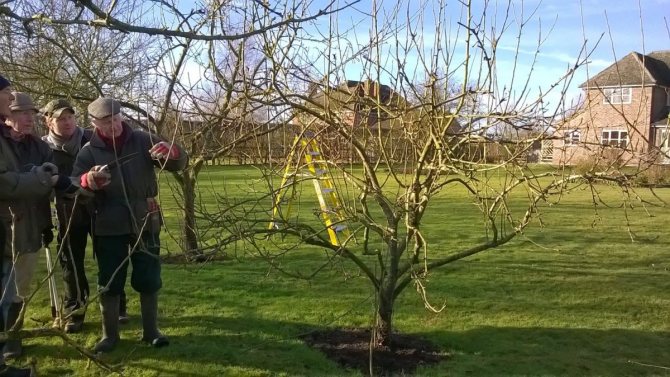
Spring care for apple trees. <>
Care and cultivation of an apple tree by seasons
Advice! Year-round caring for an apple orchard is the implementation of certain activities with their reference to the seasons.
How to properly care for apple trees at different times in order to help trees as much as possible:
- In the spring help the tree to move away from winter sleep, help develop the leaf apparatus as fully as possible and bloom. Collected here more detailed information on leaving in the spring;
- In summer the tree is maintained with proper feeding in good shape, so that it retains the maximum ovary on its branches. At the same time, they make sure that this ovary is not spoiled by diseases and harmful insects. Read this article to learn more about summer care;
- In autumn all conditions are created for the tree so that the coming harsh winter does not harm it. They also carry out pruning to ensure the "correctness" of the crown shape. You can find more information about care in the fall here.
What kind of care does an apple tree need in spring?
In general, spring care for an apple tree is no different from caring for other trees. However, each operation on the list of activities for the care of this crop at the very beginning of the season is very important. Ultimately, their implementation is able to increase the immunity of the plant, enhance its ability to withstand a whole range of diseases and pests and give an excellent harvest of apples, which, if carefully harvested, can lie for quite a long time and please with a fresh taste even in winter.
If we talk about the general stages of spring care for an apple tree, then this, of course, is sanitary pruning, whitewashing of the trunk and skeletal branches, watering, if necessary, eliminating various damages left over from the winter period, fertilizing, preventive treatments against pests and diseases, the fight against the first spring pests and diseases, as well as the protection of buds and blossoming flowers from spring return frosts. Let's consider each item from this list in detail.
Apple tree care: young and old
The main task when caring for a young apple orchard is, first of all, seedlings care apple trees and ensuring their high survival rate, forming crowns and preparing trees for long and abundant fruiting with the help dressing and chemical protection.
For more information on how to care for apple seedlings in the first year, read here.
You can also watch a video where Oktyabrina Ganichkina talks about caring for young apple trees:
How to care for an old apple tree? When caring for a fruiting apple orchard, the main concerns are good growth of young shoots, the regularity of the harvest combined with the high quality of the harvested fruit. Wherein trees are provided with water, top dressing.
Caring for the trunk of an old apple tree includes the appropriate pruning and processing from harmful insects, mold and rot.
Important! The principles of care are the creation and maintenance of a system that promotes the health and fruiting of apple trees.
Sanitary pruning of apple trees
Sanitary pruning of apple trees should be carried out as early as possible, it is highly desirable to complete it before the start of sap flow. All cuts must be made "on the ring", that is, without leaving a hemp, which can turn into a hollow over time; use only sharp tools for pruning that do not tear up the bark.
To understand what to cut, you need to carefully examine the crown of the apple tree - the first step is to remove all dry shoots, broken, too thin and those that grow directly in the middle of the crown (in the future they will certainly lead to its thickening, the transition of the crop to the periphery of the crown and its decrease).
When carrying out sanitary pruning of apple trees, pay attention to tops - these are strictly vertically growing shoots that are formed, most often in trees over five years old, they do not bear fruit, but only draw off nutrients. It is better to remove the tops by cutting them into a ring, or select a couple from the total mass and try to bend them at an angle close to 900 and so fix them. Over time, this position of the shoot will persist, it will be possible to untie it, and it will begin to bear fruit.
When sanitary pruning of apple trees, pay attention to the shoots that move too sharply from the trunk - at angles less than 450. Such, most likely, will simply break under the load from the harvest. You can already put supports under them by making ordinary spears with an elastic band in the center, for example, from a bicycle camera, or tie these shoots to higher ones, thus giving them strength to break, or simply cut out if there are a lot of such shoots.
Try to prune the apple tree when a stable temperature is established, its sharp fluctuations will stop, and if there are frosts during this period, then the temperature should not be lower than ten degrees.
When pruning this or that branch, try to have a part of the shoot after pruning at the end of the bud, directed upward and outward of the crown, so you will avoid thickening of the crown in the future.
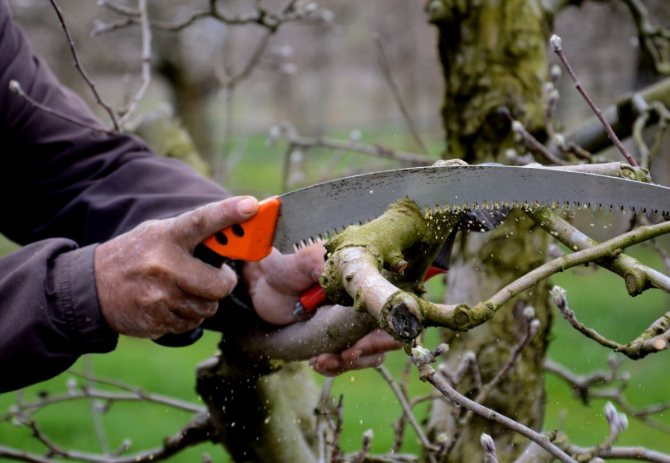

Spring pruning of an apple tree. <>
Fertilizers and feeding
The most important thing that an apple tree requires is care and feeding. To improve the conditions for root and leaf nutrition, increase or stabilize the fruiting of apple trees, enhance their resistance to frost and drought, use:
- Organic fertilizers;
- Mineral fertilizers;
- Microbiological fertilizers;
- Top dressing with a complex of microelements.
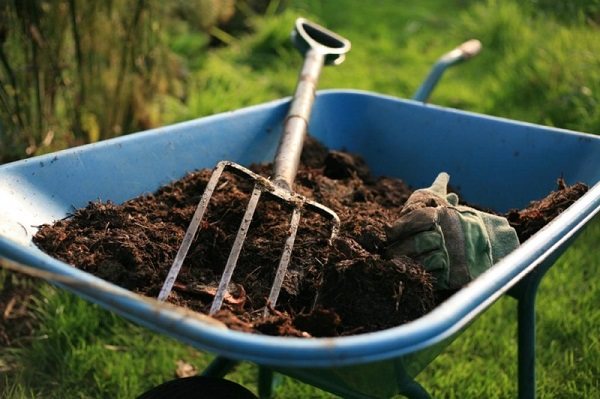

The apple orchard needs regular feeding.
You can find more information about fertilizers for apple trees here.
Removal of weeds in the near-trunk strip
Weeds appear quite quickly and grow actively, and if the apple tree is more than five years old, then, in fact, you can ignore them, but just carefully, trying not to damage the trunk, mow (preferably with a sickle). But young seedlings can suffer from weeds, for them weeds can become competitors for food and moisture.
In addition, pests and even various fungal diseases can sit on weeds for the time being. It is better to weed weeds in young apple trees by hand after rain or watering, trying to pull them out entirely, then the next time they will not appear soon.
Pruning and shaping the crown
Pruning is a complex of operations aimed at regulation of shoot growth, their subordination in relation to each other. Most often, with the help of trimming occurs crown formation the desired design and maintaining it over the years.
Pruning is an essential part of knowing how to care for an apple tree after planting and throughout its life.
All the information you need to know about pruning apple trees can be found here.
Mulching the trunk circle
Mulching is an important, necessary and simple step in caring for an apple tree in spring. The soil is usually mulched with humus; it is better not to use sawdust and especially sour peat in the spring.
With the help of mulching, you can solve a number of problems: increase plant nutrition; retain moisture by mulching the soil surface after watering; inhibit the growth of weeds by mulching the soil after they have been removed.
By virtue of all of the above, this simple trick cannot be ignored. With the help of mulch, if you cover it with a layer of 5-6 cm, you can even save the delicate root system of young plants from freezing, if suddenly the frosts decide to return.
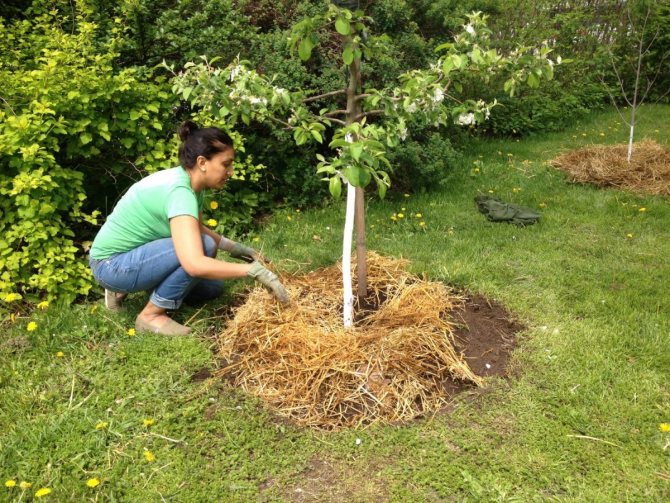

Mulching the apple tree trunk circle. <>
Props
The installation of supports in the gardens of summer residents is an important point, which includes caring for the tree: an apple tree in very productive years may simply not withstand the load... And then one cannot avoid splits and breaks of the tree or its large branches.
There are external supports - these are those that stand under the tree, or "pokes", and internal... These are called chatals and are made from steel wire.
Read how to make props with your own hands here.
Spring feeding of apple trees
In spring, the best fertilizing for an apple tree is a complex fertilizer, for example, nitroammofosk. Since there is enough melt water in the soil, top dressing can be applied dry as soon as the snow has completely melted. First, you need to loosen the soil in the near-trunk strip, then pour it with a bucket of room temperature water from a watering can (for even wetting), then scatter the fertilizer evenly.
Under an apple tree more than five years old, a tablespoon of fertilizer with a hill is needed, and half a tablespoon is enough for a tree less than five years old. After applying this fertilizer, it is advisable to level the soil and mulch with humus (with a layer of a couple of centimeters).
You can also carry out foliar feeding, for which you dilute 10 g of nitroammophoska in a bucket of water, fill a knapsack sprayer and process the plant - this is the norm for a plant older than five years, for processing younger ones, the rate must be halved.
Branch broke
If the branch young and its loss will not violate the ratio of branches in the crown of the tree, then the branch cut into a "ring", the place is cleaned, leveled and painted over with paint. If the branch thick and its loss will affect the life and productivity of the apple tree, then its connect and the junction is fastened.
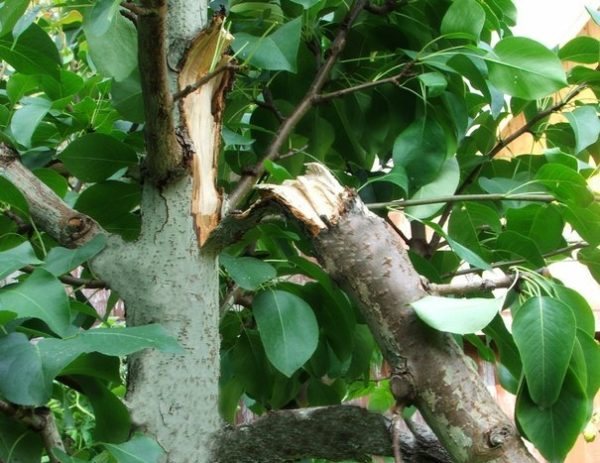

They try to attach thick branches to the trunk.
Read more here on what to do if a branch breaks.
The best winter varieties of apple trees for the Moscow region and central Russia: photo and description
The group of the best winter varieties of apple trees for the Moscow region and central Russia includes: Anise gray, Antonovka ordinary, Renet bergamot, Slavyanka, etc.
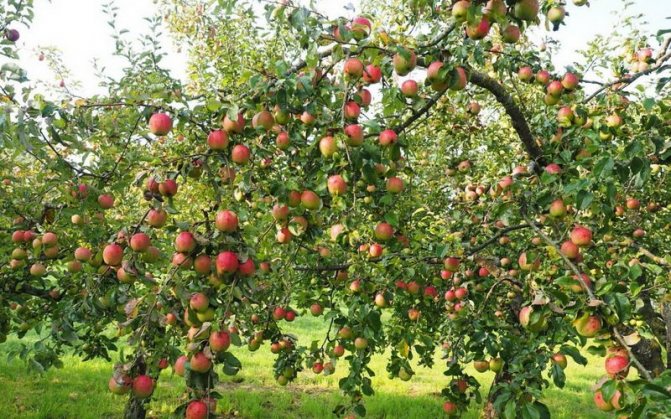

Winter grade Anise gray in the photo
Anise gray (striped)
The tree develops strongly, forming a powerful wide-pyramidal, rather dense crown. The main branches and their branches have a strong bond and withstand high yields. It restores the crown well. The most winter-hardy variety. Life expectancy is 60-80 years. There are also centenary trees.
This is one of the best winter varieties of apple trees for the Moscow region and the middle lane, high-yielding and fast-growing. Begins to bear fruit from the 5-6th year. The harvests are annual. In the period of initial fruiting, the yield is moderate, and at the time of full fruiting, it gives high yields: 300-350 kg of apples are often harvested from individual trees. Early flowering.
As you can see in the photo, this variety of apple trees, recommended for the Moscow region, has medium-sized fruits, sometimes small (60-75 g), flat-round, slightly conical, with a light green aromatic skin covered with a grayish-red smoky bloom or numerous reddish stripes:
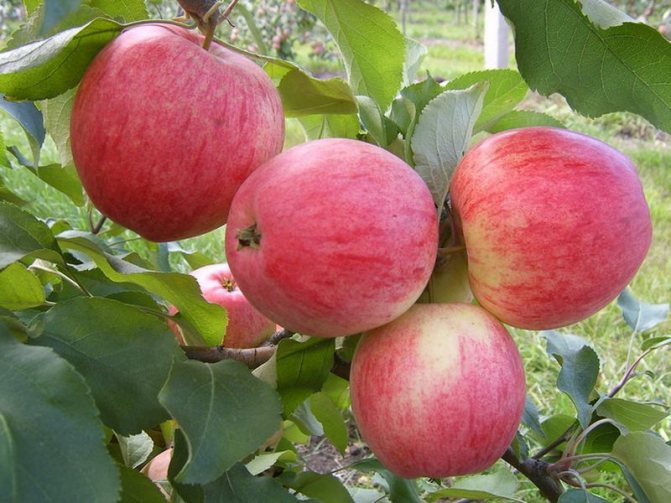

Apple of the "Anise gray" variety in the photo
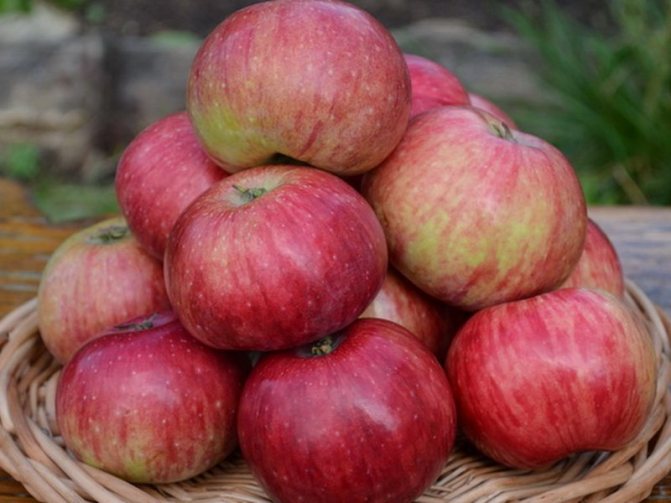

Fruits of apples "Anis" are flat-rounded, slightly conical
The pulp is light green, juicy, sweet and sour with a spice taste.
Fruit picking - in the second half of September. They remain in bed until February.
Gray anise is the best variety of apple trees for fresh consumption and for technical processing (dough, jam, juices, confectionery); good for lobe.
The main variety in all areas, both rain-fed and irrigated orchards. Although it is drought-resistant, when irrigated, the size of the fruits and their yield increase dramatically.
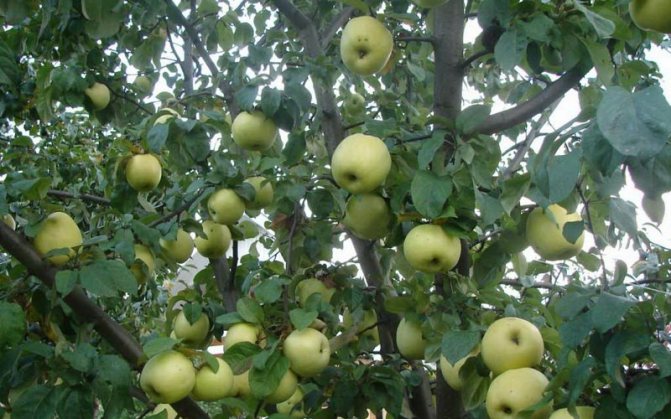

Apple-tree "Antonovka ordinary" in the photo
Antonovka ordinary
The tree grows to a large size, forming a well-developed spherical crown with the main branches firmly attached to the trunk. Relatively frost-resistant. When describing this winter varieties of apple trees recommended for the Moscow region, it is worth noting that it grows and bears fruit better on moderately moist or irrigated soils.
Begins to bear fruit from 7-8 years. The yield is high, with a rapid increase in the period of initial fruiting. This necessitates systematic fertilization.
Look at the photo - when describing this winter variety of apple trees, it is especially worth noting large (on average 120-150 g), round-cylindrical or conical with wide ribs, light yellow, with a strong aroma of fruits:
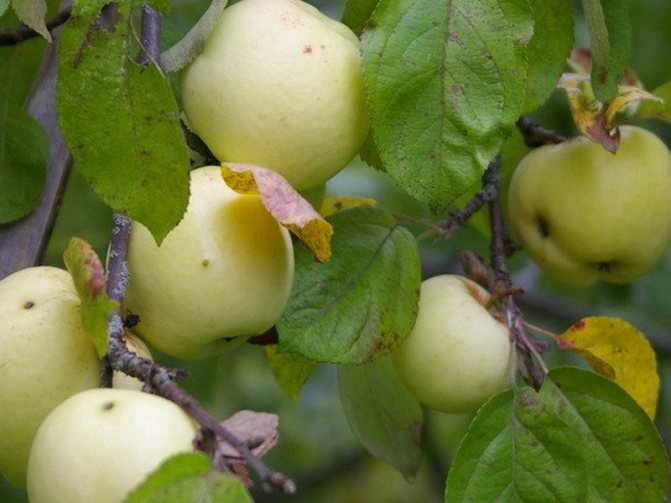

Winter apple variety "Antonovka ordinary" in the photo
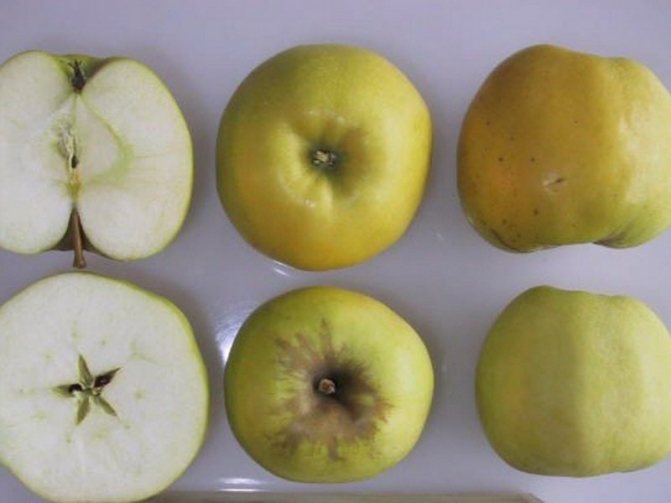

The fruits of the "Antonovka ordinary" apple tree are round-cylindrical or conical with wide ribs
The pulp is white, juicy, sweet and tartaric and has a pleasant taste.
Blooming later. Fruit picking - at the end of September. Ripening in October - November. It is stored for 3-4 months, a valuable variety for fresh consumption and technical processing: it is used in large quantities for the preparation of marshmallows, candied fruits, marmalade, jelly, and apple dough; good for lobe.
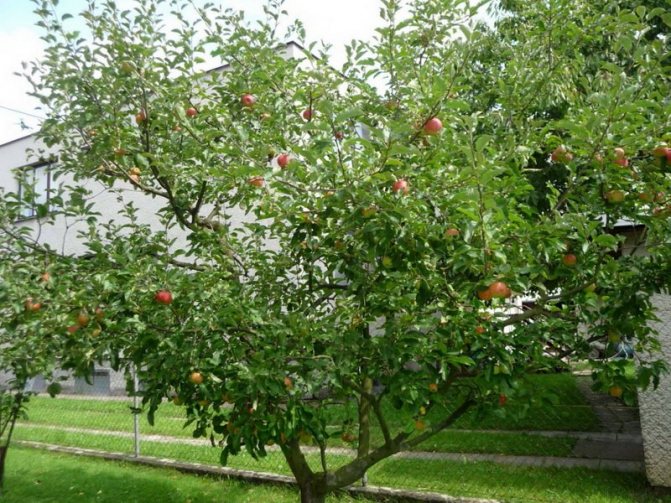

Apple-tree variety "Antonovka-Kamenichka" in the photo
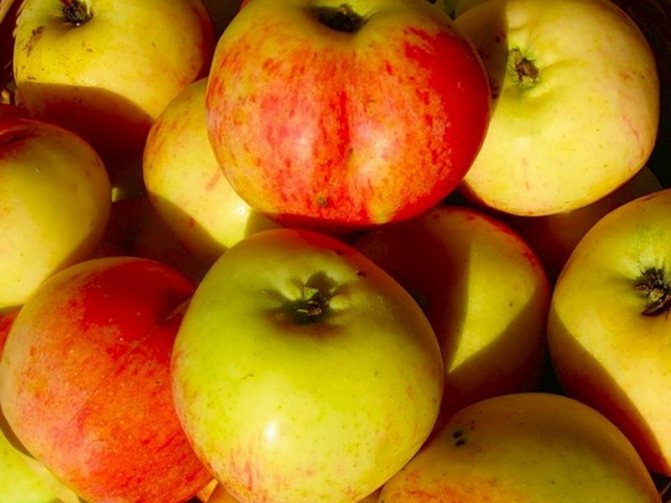

The apple-tree "Antonovka-Kamenichka" in the photo
Antonovka-kamenichka
This winter variety of apple trees, recommended for the Moscow region, differs from Antonovka ordinary in a smaller size of fruits with a blush on them and a more compressed crown of the tree. The yield is also good. Keeping quality - 4-5 months.


Apple-tree variety "Renet bergamot" in the photo
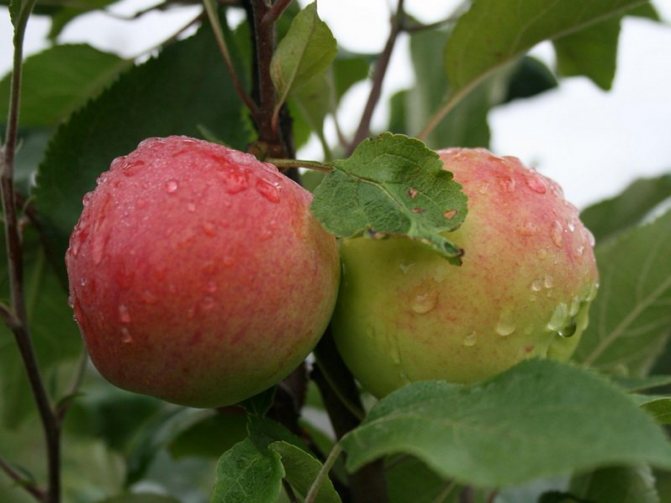

Apple fruit "Renette bergamot" in the photo
Renette bergamot
This winter variety of apple trees, grown in the middle lane, was obtained by IV Michurin from the seeds of Antonovka six hundred grams.
The tree is vigorous, with an oval, medium-dense crown, with strong main branches. In the conditions of the region it tolerates winter well. Begins to bear fruit from 6-7 years. Productivity is high: in the conditions of the region it is not lower than that of Anis gray. Medium early flowering.
Fruiting mainly at the ends of the fruit twigs, which must be taken into account when pruning.
Insufficiently resistant to scab, especially in rainy years or in low places.
Fruits are large or medium (average weight 120-125 g), onion-shaped, without ribs. The peduncle lacks the usual funnel, and some fruits have a tubercle here, like pears. When removed, the fruits are green, and when lying down, they acquire a yellow color, often with a pinkish "tan" on the sunny side. The pulp is firm, sweet and sour.
Late winter variety. Fruit picking - at the end of September. Fruits are stored for 6-7 months. They tolerate long-distance transportation well. Are consumed fresh.
Here you can see photos of the best varieties of apple trees, the description of which is given above:
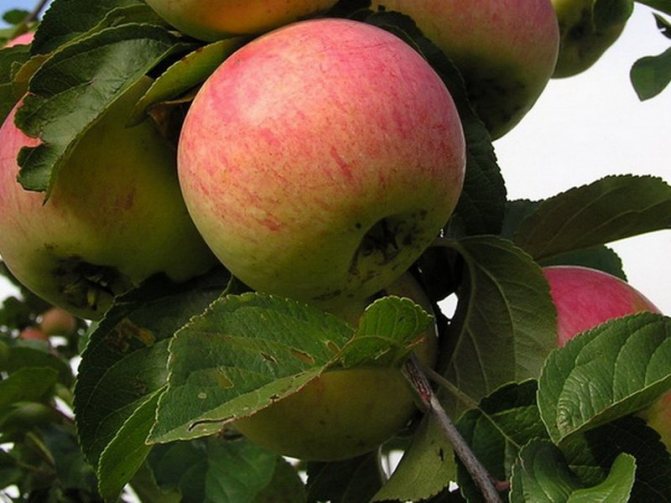

Yaloko variety "Anise striped" in the photo
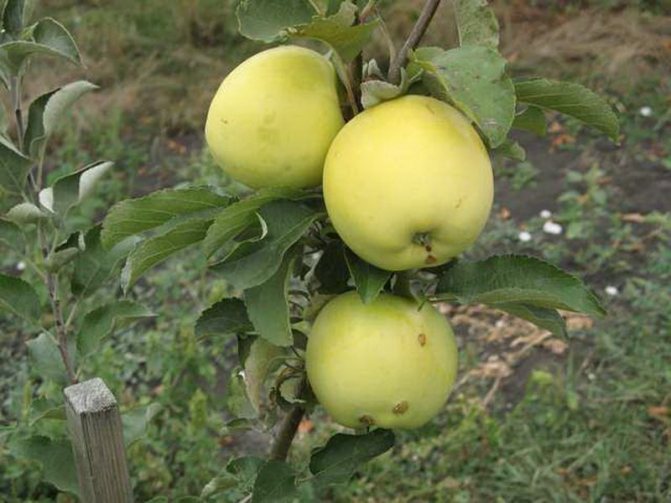

Apple variety "Antonovka ordinary" in the photo
Preparing for winter
Since the winter period in most of the Russian Federation is very unfavorable for apple trees, then preparation for winter problems is necessary:
- Moisture-charging irrigation;
- Healing wounds or hollows;
- Correct pruning.
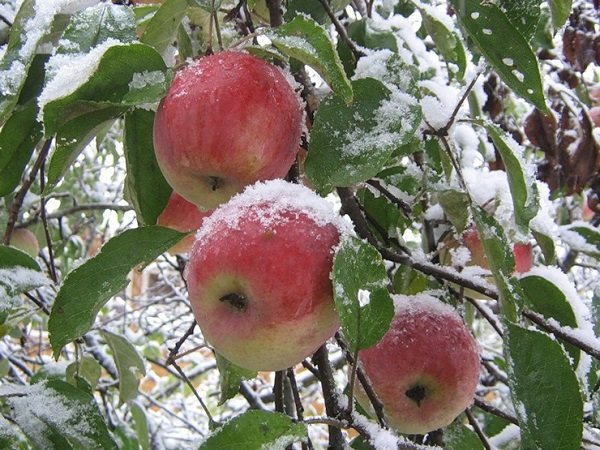

Preparing for winter is an important point of care.
Read more about preparing apple trees for winter here.
How to choose?
Before you buy seedlings for your garden, you need to carefully consider the issue of studying varieties. Apple trees should be suitable in all respects for the region.Here's what you should pay attention to when choosing the best varieties for central Russia:
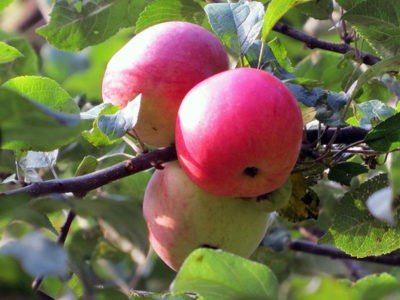

The resistance of the variety to winter cold... The tree must withstand severe winter frosts and spring frosts, withstand sharp autumn drops in temperature, typical for central Russia.- Fruiting... The first harvest from early ripening varieties of apple trees can be removed in the 2nd - 4th year; from medium-fruited to the 5th - 8th year; from late-fruited - on the 9th - 10th - 12th year.
- Yield... It is better to choose apple varieties that will bear fruit every year.
- Ripening period of apples... The varieties are divided into three periods: early, middle and late.
- Keeping apples... The best winter varieties of apples can retain all qualities until the end of spring. For autumn varieties, good keeping quality is considered to be 1-2 months.
- Disease immunity... Trees with high resistance to diseases and pests will require fewer treatments. This will save time and budget for further care.
- Crown shape... Depending on the size of the garden, you can choose a variety of apple trees with a small or medium, compact crown habit.
- Taste qualities of fruits: sweet, sour, juicy, with firm or loose flesh.
Apple Garter
There are two types of garters. In the first, tie up young tree to pegs or trellis to give stability and create the correct crown.
In another case, a garter is simply necessary for mature young treewhen its fruits on some branches are too large or the fruits are numerous, and the failure of such branches can break them off. In the latter case, use wire, twine or fabric belts.
Read more about how to tie an apple tree correctly here.
What popular winter varieties of apple trees are best planted in the middle lane
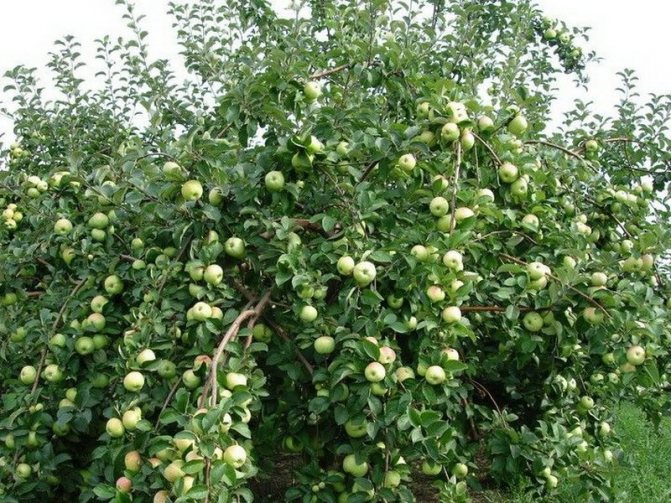

Apple-tree variety "Slavyanka" in the photo
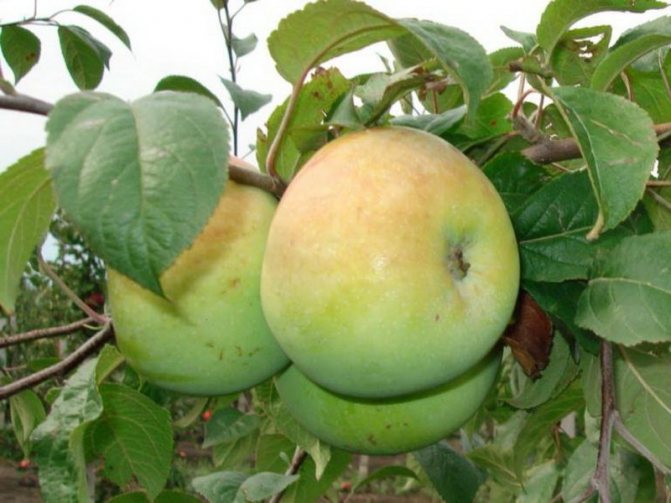

The fruit of the apple tree "Slavyanka" in the photo
Slav
This popular winter variety of apple trees for the middle lane was obtained by IV Michurin by crossing Antonovka vulgaris with pineapple. The variety is fast-growing, high-yielding. Begins to bear fruit from 4-5 years with a rapid increase in yields over the years.
The tree is of moderate development, forms a rounded, medium-spreading beautiful crown. Good winter hardiness. Blooming later.
Fruits are of average or below average size (average weight 60-65 g), bulbous-round, yellowish-green when removed, turn yellow in maturation. The pulp is juicy, tender, of excellent tartaric taste.
Fruit picking - at the end of September; consumer maturity - mid-November. Remains in prone for 5-6 months; carry long-distance transportation. The best dessert variety.
This is one of those apple varieties that are best planted in the suburbs on fertilized, moderately moist or irrigated soils. With a lack of moisture, it gives small fruits.
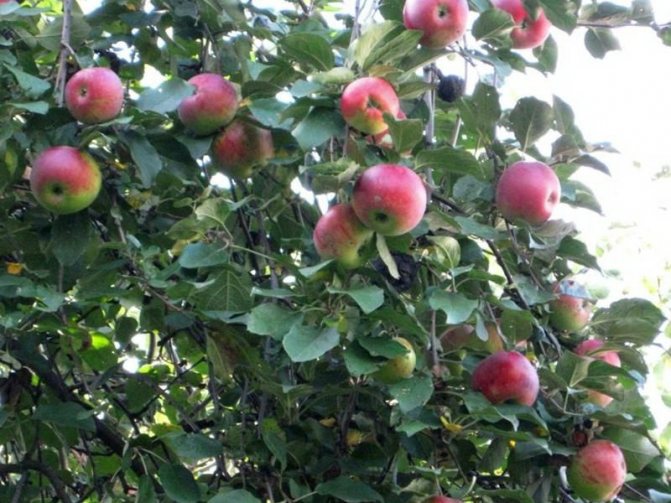

Apple-tree variety "Skryzhapel" in the photo
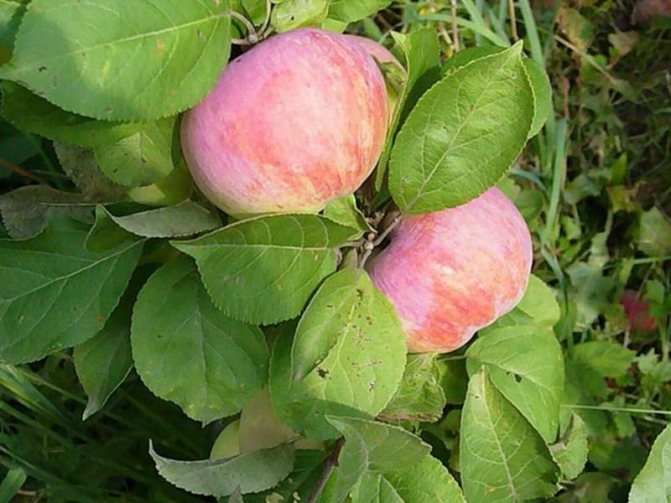

The fruits of the Skryzhapel apple tree in the photo
Skryzhapel
The tree is vigorous, with a pyramidal crown. Good winter hardiness. Begins fruiting in the 5-6th year. Productivity is high Flowering - in medium terms.
At the age of initial fruiting, it gives moderate yields, and at the age of full yields, high.
Fruits are medium, flat-rounded, strongly ribbed, yellow-green, with dark red densely spaced solid and intermittent stripes.
This is one of the best apple varieties for the middle lane with a dense, juicy, light green pulp of a sweetish taste, with a slight acidity. Fruit picking - at the end of September. They remain in bed for 6-7 months. Transport is well tolerated. Often they are affected by scab.
The variety is found in several forms, differing in yield, fruit size and color. When propagating, it is necessary to take cuttings from trees that are more productive, with large and better colored fruits.
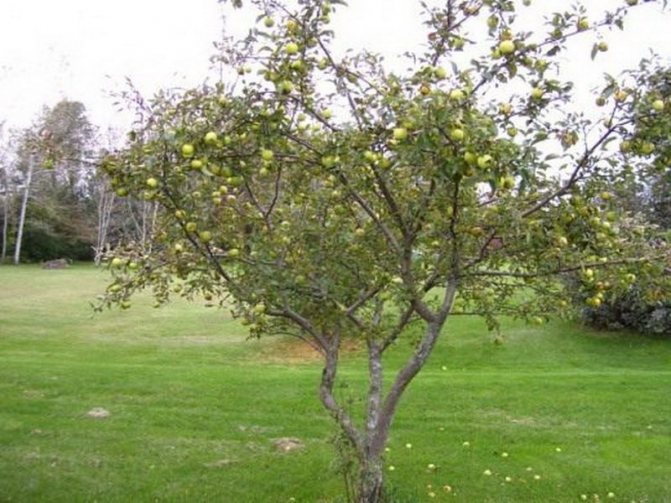

Apple-tree variety "Borsdorf-Kitayka" in the photo
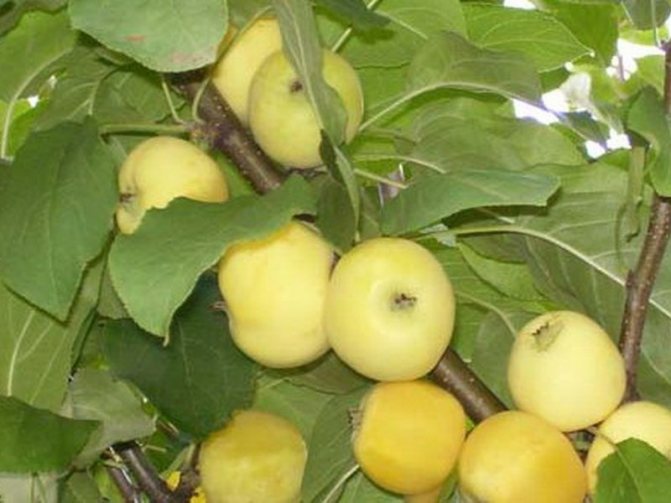

Apple fruits "Borsdorf-Kitaika" in the photo
Borsdorf-Chinese
The variety was bred by I.V.Michurin by crossing Bulbous Borsdorf with Chinese.
Trees of medium development. Average winter hardiness. In fruiting come from 5-6 years with a rapid increase in yields over the years. The yield is high: at the age of 12, it gives up to 130 kg per tree. Fruits are medium or below average size (average weight 60-70 g), rounded, smooth, greenish, yellow-green in maturation with whitish barely noticeable subcutaneous punctures, sometimes with a blush on the sunny side. The pulp is dense, juicy, sweet and sour, excellent taste with a slight spice.
Fruit picking - at the end of September. Consumer maturity in November - December. They remain in bed for up to 10 months. This is one of those apple varieties that are best planted in the Moscow region, the fruits tolerate transportation well.
Higher yields and better marketable fruits are produced in irrigated orchards.
This collection contains photos of winter varieties of apple trees recommended for the Moscow region of central Russia:
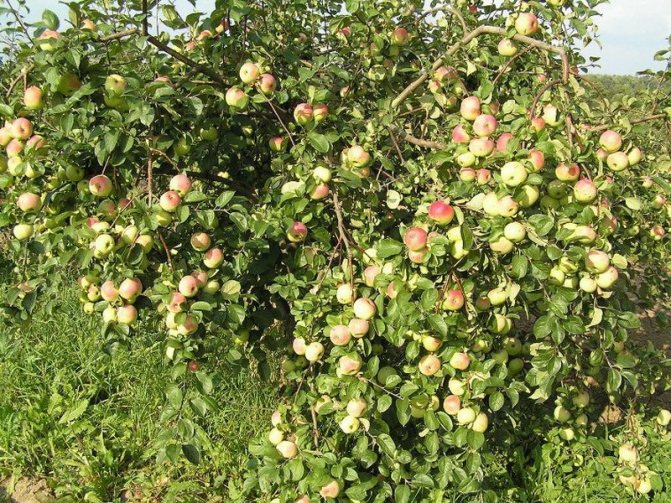

Apple-tree variety "Winter dessert" in the photo
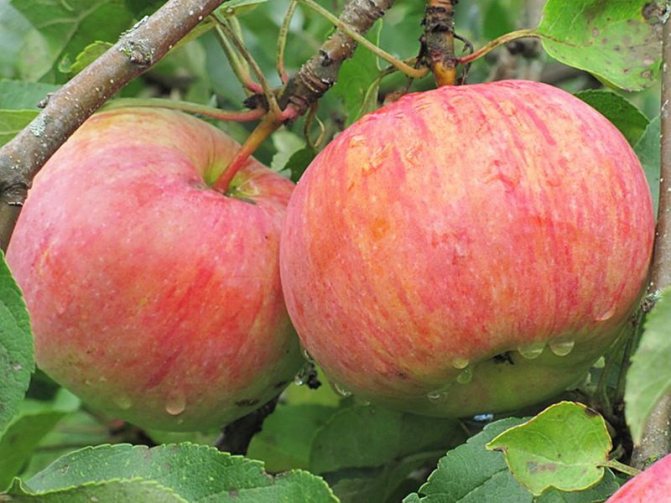

Apple fruits "Winter dessert" in the photo
Winter dessert
The variety was bred by S.P.Kedrin in 1935 by crossing the saffron Antonovka with the London pepin. The tree is winter-hardy, of medium vigor, with a flat-rounded crown. The variety is winter, its yield is high - in the 3rd year of fruiting, the tree gave 21 kg of fruit.
The fruits are rounded-conical, of medium size, weighing about 100 g (larger than anise), covered with a bright speckled-striped blush along the main yellow color of the skin in the form of shiny carmine stripes and broad strokes with a strong bluish bloom.
The pulp is light yellow, juicy fine-grained, dense, tender, excellent sweet-sour taste. Removable ripeness occurs in the first half of September. Keeping quality and consumption period are longer than that of anise and Antonovka vulgaris (from October to March). Recommended for testing in all areas of the middle lane.
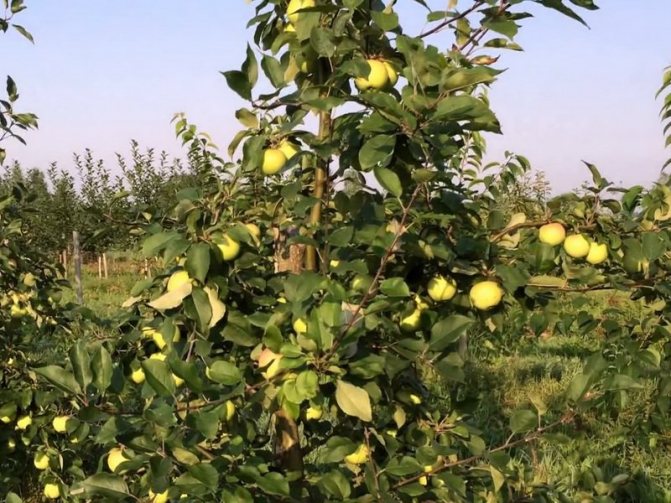

Apple-tree variety "Yellow ribbed" in the photo


Apple fruit “Yellow ribbed” in the photo
Yellow ribbed
The variety was bred by S.P. Kedrin in 1935 by crossing Antonovka saffron with Pepin of London. The tree is winter-hardy, medium-sized, with a rounded crown. The variety is typically winter. The annual yield is high. In the 3rd year of fruiting, the tree produces 19 kg of fruit.
Fruits are of medium size (larger than anise), conical in shape, with pronounced ribbing in the upper part of the fruit. The description of this variety of apple trees, recommended for the Moscow region, is quite consistent with the name: its fruits are yellow, with an orange-red tan on the sunny side.
The pulp is light yellow, juicy, dense, fine-grained, with an excellent sweet and sour taste. Removable maturity - in the second half of September. The fruits ripen in October - November and remain in maturation for a long time without losing high dessert qualities, having in this respect advantages over local varieties.
Further you can familiarize yourself with the photo, name and description of apple varieties, whose fruits ripen in autumn.
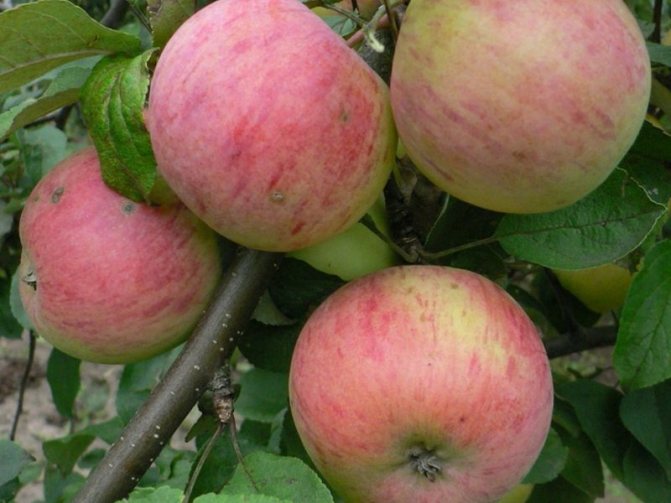

"Winter dessert" in the photo
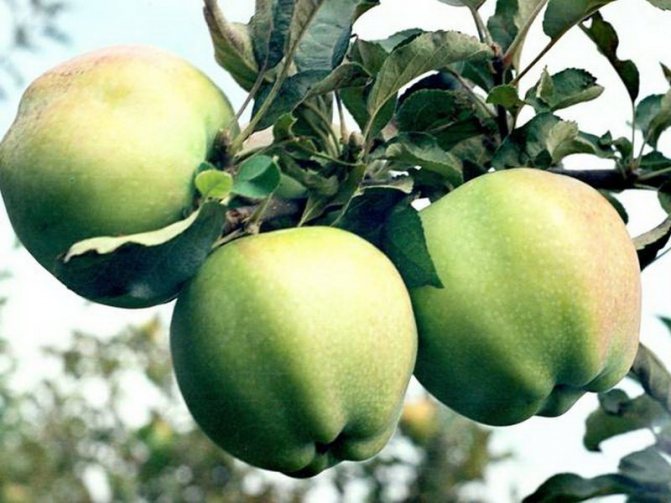

“Yellow ribbed” in the photo
How to cover up the cut?
Any cut, wound or peeled bark should be be sure to cover up and the sooner the better. As the wound is weathered, the edges dry out, and various microbes and rot spores freely penetrate into the branch or trunk.
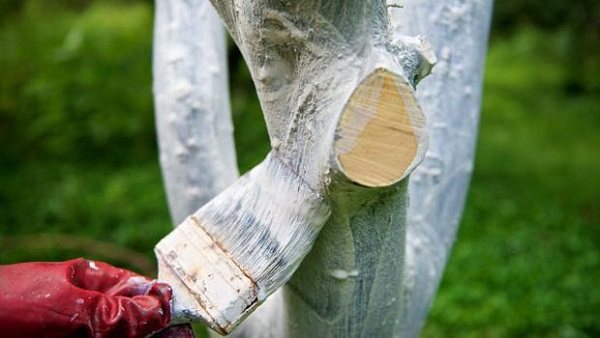

You need to process the saw cut as soon as possible.
The mixture for protection should be on the one hand biogenic, that is, non-toxic for the apple tree, but at the same time protect the wound from the sun, drying wind, sudden changes in temperature and not washed away by rain and snow. In addition, she must stick quickly both to a wet cut and to old dry bark and wood (var, oil paint, clay with additives, etc.).
Read more about the best way to cover up a saw cut on an apple tree.
Whitewashing the apple tree
Spring whitewashing of apple trees can be carried out both with lime and with white acrylic-based breathable garden paints.
Read more about the composition of solutions in the article "Spring whitewashing of fruit trees"
It will not be superfluous to remind once again about the advantages of spring whitewashing. It protects the trunk and skeletal branches from sudden changes in day and night temperatures, when the bark can not withstand and simply crack, fall off, and this does not bode well for the tree.
Whitewashing protects against rodents and a number of pests that do not attack whitewashed plants. This method can also cope with fungal diseases, especially if lime is used.
Remember that spring whitewashing can easily be washed away by rain, and you may need to repeat this process two or three times in the spring.
Carry out the whitewashing always starting not from the top, but from the bottom and move to the first skeletal branches, trying to "capture" them too.
For young trees, whitewashing with lime can be dangerous, cause burns to the bark, and if you could not get the acrylic-based white garden paint, then whitewash the young trees with ordinary chalk, dissolving it thicker, bringing the composition to a creamy state.
Cobwebs on the leaves
Very often, the appearance of snow-white or grayish cobwebs on apple branches and leaves is associated with activity pest insects in the caterpillar stage... These are apple sucker, and apple moth, and leaf-gnawing caterpillars, and even spider mites. Or it is the wintering cocoons of the hawthorn.
In any case, either folk decoctionsif the pest is small, or radical synthetic store insecticides with a large number of tracks.
You can find more information about the spider web on the leaves of the apple tree here.
Understanding apple varieties: winter, summer and autumn
Most likely, there is not a single summer cottage or garden in which an apple tree has not been planted. This tree is ideal for growing in temperate climates, and most importantly, it bears fruit of amazingly tasty fruit, which is one of the most popular and sought-after fruits in the kitchen. There is an unimaginable number of apple varieties, which is why it can be very difficult to limit your choice to a few or just one variety.


The best varieties of apples
When to whitewash apple trees?
Whitewashing is carried out at the end of winter and is used only in young orchards to reduce the risk of sunburn of the bark on the branches and trunks of apple trees.
The most commonly used solution is based on copper sulfate (17 grams per liter of liquid) and fluff lime. It is brought in enough to bring the mass to the state of a pancake dough.
When and how to whiten apple trees correctly, you can learn in more detail from this article.
Protecting the apple tree from pests and diseases
Usually, in the spring, a whole series of preventive treatments against diseases and pests is carried out. They start with treatments with copper-containing preparations, it can be a 2% Bordeaux liquid or a 3% solution of copper sulfate. Trees should be sprayed with a spray bottle or knapsack sprayer, trying to moisten all branches completely.
Further, more serious drugs are used. For example, "Horus" is used against scab and moniliosis on an apple tree, for protection against powdery mildew - "Skor" and similar approved drugs.
Against pests, such as the moth, when the years of individuals begin, you can treat the plants with the drug "Alatar", which also helps from the leafworm; "Ivanhoe" - will reliably protect against aphids, "Fitoverm" - will allow you to cope with ticks.
When treating apple trees against diseases and pests, strictly follow the instructions on the package.
In addition to chemicals, various biological preparations can be used, pheromone traps can be hung, trapping belts can be pasted - dry, adhesive, poisonous. The main thing is to often replace them with new ones or clean them.


Apple tree in the spring under the snow.
The apple tree cracked, cracked
If the tree pull tight after splitting or cracking during the day from the moment of the incident, having collected all its parts together and fixing them, then it will quickly overgrow its "fracture" and will continue to bear fruit further.
More often used wire structures and bolting.
For more information on what to do if the barrel is cracked, read here.
What are the common features of autumn varieties?
Autumn varieties of apple trees have many similar characteristics, by which they can be distinguished from summer and winter varieties.
- Autumn apple flavor is a cross between winter and summer varieties. They mix the sweetness of summer varieties and the juiciness of winter ones, with a bite you can hear a characteristic crunch.
- All such varieties ripen from about early to mid-September.
- Collecting apples of autumn varieties is necessary before they themselves begin to fall from the tree. This will at least preserve their integrity. It is important after collecting the fruits to let them lie down for 15 days, and only after that they can be eaten.
- The shelf life of autumn apples is shorter than winter apples, but under proper conditions they will last until early January.
Watering
In the main apple growing areas, orchards need irrigation... In such areas, watering is carried out in the following ways:
- Along furrows;
- Sprinkling;
- They do drip irrigation.
The choice depends on the site, its soil and water source.
Attention! Watering is required to provide a sufficient amount of moisture, but without overflow.
Read more about how to properly water apple trees here.
Protecting apple flowers from spring return frosts
It is not uncommon for years when the return cold kills the flowers and leads to the fact that we do not get the harvest in the form of apples at all, no matter how much we care about the apple tree. It is difficult to help in any way, but you can try. The simplest and rather reliable option is to light smoky fires along the periphery of the site by a contract with the neighbors, if they do not mind, this can raise the air temperature in the garden by a couple of degrees and save the flowers from freezing. One drawback is that the weather must be calm and the fires must be maintained until the frost is gone.
Sometimes sprinkling helps, when all the trees are literally sprayed with tiny drops of water from a hose with a special nozzle. Water, falling on trees and flowers, freezes in the frost, giving its warmth to the plant.
We hope our article will help you in practice. And with the help of such simple measures in the spring, you can provide yourself with a decent harvest of apples both in summer and in autumn.
Useful Tips
- If the apples are affected by scab, and the leaves are healthy, then most likely the tree is missing molybdenum, top dressing next spring will get rid of specks on the fruits;
- For a larger number of apple ovaries during the flowering period, spray honey solution 1 to 9 will definitely attract bees;
- Sowing siderates important, it will enrich the soil with organic matter and increase the number of enemies of insect pests.
You can get even more helpful tips from the video below:
The best summer varieties of apple trees for the Moscow region and the middle lane


Apple-tree variety "Moscow Grushovka" in the photo
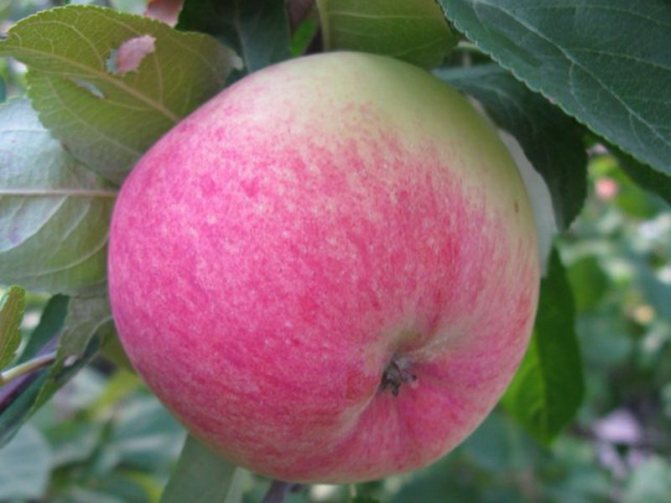

The fruit of the apple tree "Moscow Grushovka" in the photo
Grushovka Moscow (Skorospelka)
An old Russian variety, widespread everywhere.
Trees reach large sizes, form an elongated-oval crown with strong and thick main branches of medium density, covered with light green long leaves. Frost resistance high Yield durable. A fast-growing variety - begins to bear fruit from the 5th-6th year with a rapid increase in yield; at the age of full fruiting (20-50 years), yields of 200-250 kg per tree per year are not uncommon. Early flowering.
Fruits are small, flat-conical, with a thin, shiny skin covered with pink-red stripes. The pulp of this one of the best summer varieties of apple trees for the middle lane is yellow-white, juicy, soft, with a pleasant sweet and sour taste. The fruits begin to ripen in early August. Their maturation is uneven.
Removal of fruits - in 2-3 doses, in order to avoid shedding.
Not suitable for long-distance transportation. Can persist for 1-1.5 months. Consumption - fresh and for technical processing.
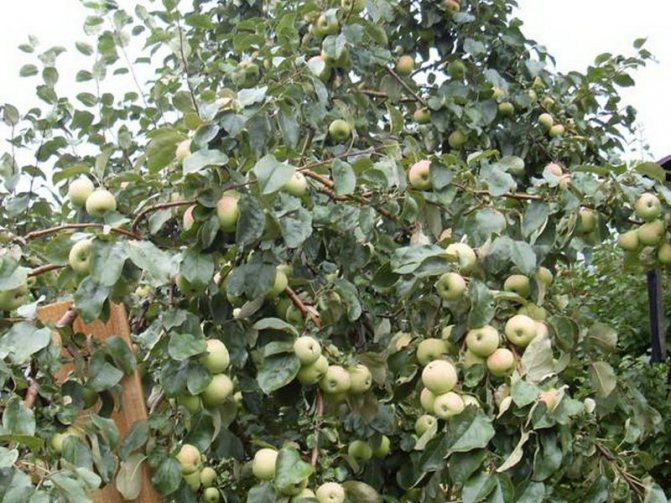

Apple-tree variety "Pouring white" in the photo
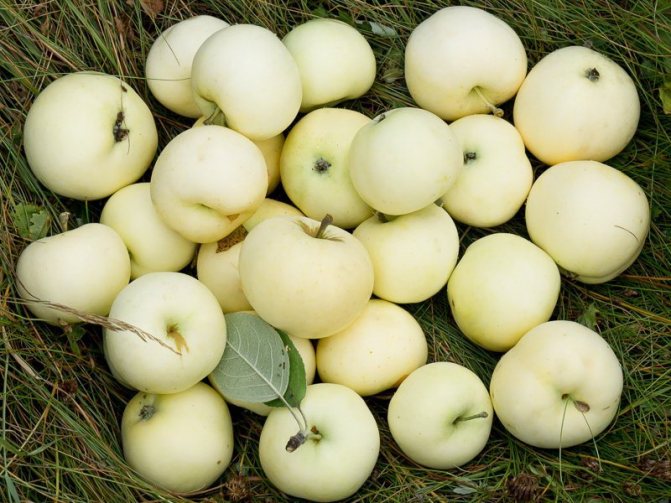

Apple fruits "Pouring white" in the photo
Pouring white (Pudovshchina, Dolgostebelka)
Trees of moderate growth, forming a spherical, medium-dense crown with light green foliage. The variety is winter-hardy and productive, especially on strong soils. Strongly affected by scab, especially in low places. Begins to bear fruit from the 5-6th year. Medium early flowering.
The fruits of this summer variety of apple trees, recommended for the Moscow region, are of average or below average size, round-conical, light yellow. The pulp is white, fine-grained, sweet and sour taste. Ripen in the second half of August. The fruits last for about a month, but quickly deteriorate in taste. Transport is not well tolerated. They are consumed fresh, they can also go for technical processing.
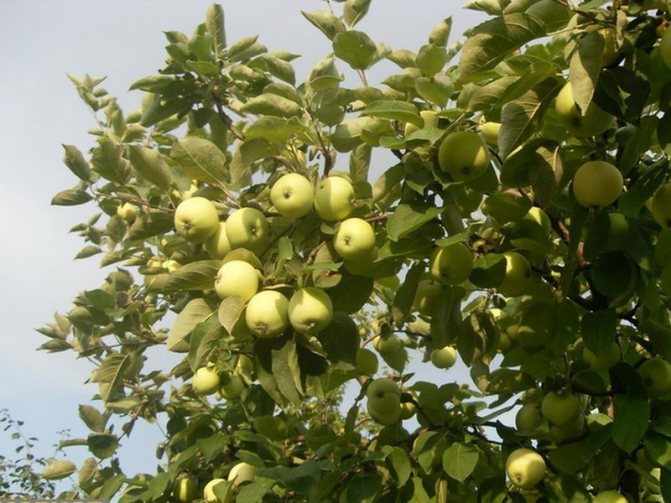

Apple-tree variety "Alabaster" in the photo


Apple fruits "Alabaster" in the photo
Alabaster (Papirovka)
The spread is small. The trees are vigorous, with an oval-rounded crown covered with light green leaves. Average winter hardiness. It is more resistant to scab than White filling. The yield is good, almost yearly. The variety is early-growing, early summer. Fruiting in 4-5 years. Blooms in medium terms.
Fruits are of medium size (about 80 g), round-conical or oval, with wide ribs, on one of which a seam stands out (a fold is the main distinguishing feature), light yellow, with a bloom and green subcutaneous dots. The pulp is white, juicy, of excellent tartaric and sweet taste.
Fruit picking - at the beginning of August. Consumption - fresh. They are stored for about a month. This is one of those apple varieties for the Moscow region, which are recommended to be grown for quick consumption, since the fruits are not transportable. A good dessert variety.


Apple-tree variety "Malt Bagaevsky" in the photo
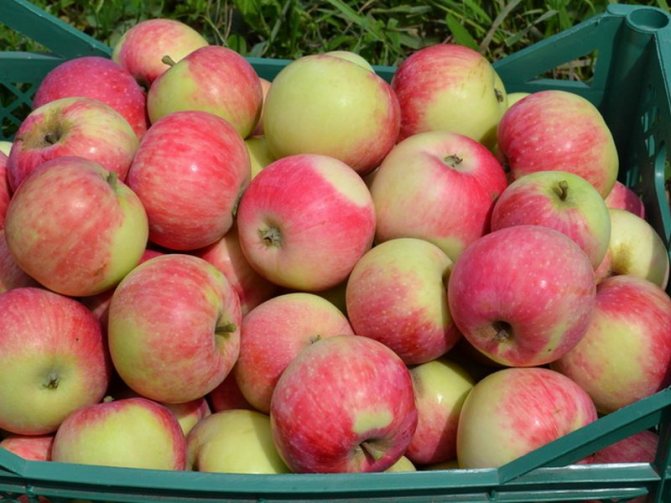

Apple fruits "Malt Bagaevsky" in the photo
Malt bagaevsky
The trees are vigorous, with a broadly spreading, medium-dense crown. Their winter hardiness is good, not lower than Anis scarlet and other winter-hardy varieties. Begins to bear fruit from 6-7 years. Productivity is high: in the period of full fruiting, it gives on average about 80 kg per tree, and from individual trees - 150-200 kg or more.
Fruits of medium size, but larger than Anise scarlet, flat-rounded, with a white skin covered with a bright crimson-red blush and a light bloom, very beautiful.
The pulp is juicy, tender, white, good sweet and sour taste. Fruits ripen in mid-August. They tolerate transportation well. They persist for about 40 days. Are consumed fresh.
Next, you will find out what other good varieties of apple trees are recommended for the middle lane and the Moscow region.
Below is a description of what other varieties of apple trees are best planted for the summer harvest.
Testimonials
Marina, Altai Territory: “I won't praise too much, but this is one of the best among autumn varieties. We planted a hybrid to eat fresh apples and prepare blanks. The husband makes delicious liqueur, the spicy aftertaste only colors it. "
Alina, Kursk: “The apples are delicious, sweet, with an interesting taste. The tree, however, is very tall, you need to constantly monitor so that the shoots do not get out of the general picture. We carry out pruning constantly. Otherwise, there is no trouble with the apple tree. "
Svetlana, Ukraine: “We have had this apple tree for a long time, for sure about 20 years. Previously, there were no problems, but in recent years it has begun to freeze a little in winter. Either her age makes itself felt, or the climate has changed. "
Apple-tree Bessemyanka Michurinskaya
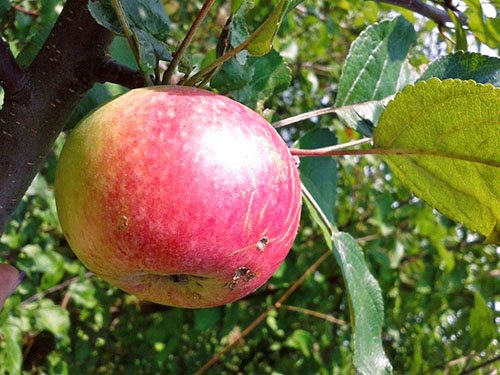

A vigorous variety, obtained by IV Michurin, as a result of crossing between Bessemyanka Komsinskaya and the Skrizhapel variety, has a powerful spreading crown and begins to bear fruit from 5 to 7 years after planting. The average yield of an apple orchard planted from trees of the Bessemyanka Michurinskaya variety is 130 kg per plant.
Flowering begins in the second half of May, and fruits ripening in September weigh 110-130 grams and are distinguished by excellent taste. The apple of the Bessemyanka Michurinskaya variety has a light yellow integumentary color and a blush of merging orange and red stripes throughout the skin of the fruit that retains its freshness until December. Apple trees winter well in the middle zone and are rarely affected by scab. The only drawback of the variety is the uneven ripening of crumbling apples.
Apple tree Anis Sverdlovsky
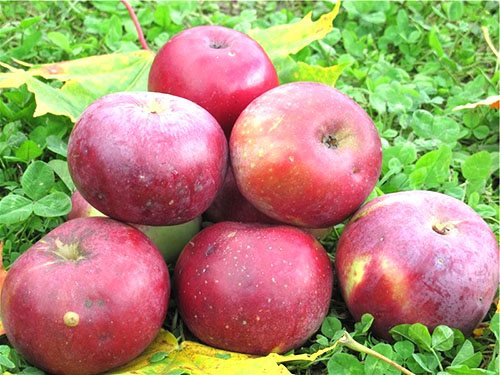

The apple variety Anis Sverdlovsky, which yields a harvest in late autumn, is the fruit of the work of the breeders of the Sverdlovsk Experimental Gardening Station, under the leadership of L.A. Kotova. The plant was grown thanks to the crossing of Melba and Anis purple, while the crown of the apple tree is closer in shape to an oval or a wide pyramid. The tree is medium-sized with a mixed type of fruiting. Although on the densely strewn branches of two-year-old ringlets, most of the pink flowers are formed, and then the ovary.
The regular round or oval fruits of the Anis Sverdlovsky apple tree have an average weight of 100 to 120 grams. Apples have dry, smooth, medium-thick skin with a light yellow integumentary color, which is sometimes almost invisible under a deep red blurred blush. On ripe fruits, a wax bloom of a bluish tint is clearly visible.
Apples have juicy fine-grained flesh of white or sometimes greenish tint. The taste of ripe fruits taken from the apple tree of Anis Sverdlovsky in early September is sweet and sour, deserving high expert assessments. However, this autumn variety cannot be called maturing. The maximum storage period is December. The tree gives the first ovary already in the fourth year after grafting, tolerates winter well and even after frost damage to individual shoots, it quickly recovers, but in rainy seasons it is often affected by scab.
Apple Cinnamon new
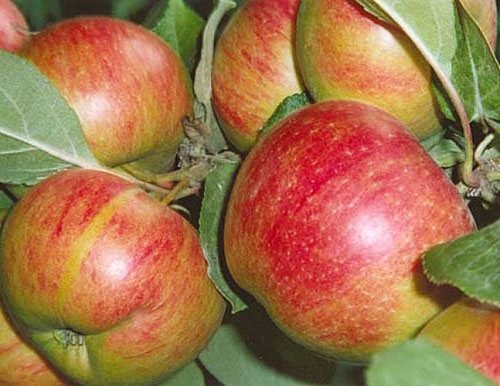

A well-known variety of late autumn ripening was developed on the basis of VNIIS im. I.V. Michurin, the famous breeder S.I. Isaev. The apple tree variety Cinnamon striped and variety Welsey were chosen as the starting material for hybridization.
The variety, which entered the State trials in 1950, was released 15 years later for cultivation in the Central and North-West regions of the country. In the non-chernozem zone of Russia, apple orchards, established from vigorous strong trees of this variety, are actively used today. The variety is high-yielding, has good scab resistance, and exhibits average winter hardiness in the center of Russia.
The crown of a young Cinnamon new apple tree has a shape close to pyramidal, but as it grows, it expands and becomes rounded. Most of the ovary is formed on annelids, and only a small part is formed on elongated flexible fruit rods. Apple trees begin to bear fruit relatively late, only at 6–7 years of age, while in mature trees the years of abundant harvests alternate with periods of dormancy.
The Cinnamon nova apple tree is characterized by large, dark green ovoid leaves with pointed elongated tips, noticeable pile and jagged edges. When the plant blooms in the second half of May, the tree is covered with large white-pink flowers, in the place of which fruits are subsequently formed, weighing from 20 to 180 grams. Rounded-conical or slightly flattened apples of this variety are covered with a thick, smooth skin of a greenish-yellow color with a speckled or blurred striped blush of a red-carmine shade.
The fruits of Cinnamon New are distinguished by the highest commercial qualities, they are juicy with a sour-sweet taste and are in no way inferior to most southern varieties. The apples, picked in early September, fully reveal their taste after 3 - 4 weeks, and in a cool room they can be stored until winter.
Recommendations
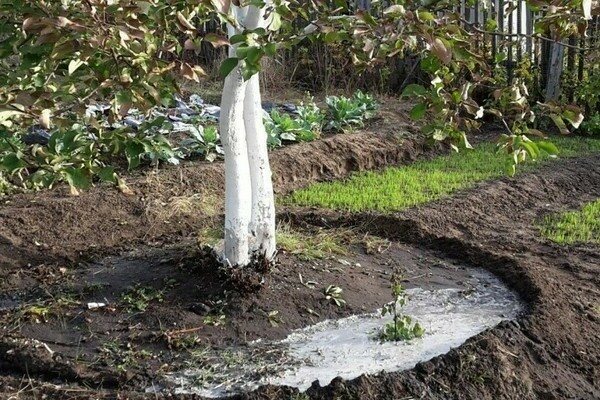

If black dots, the so-called scab, appear on the fruits of the apple tree, and the leaves, meanwhile, look very healthy, the apple tree is probably experiencing a deficiency of molybdenum.In this case, the tree is fed in the spring to help prevent scab.
In order for the harvest to be as large as possible, during the formation of flowers, the tree should be sprayed with a solution of honey mixed with water, prepared at a rate of one to nine. This is done in order to attract pollinating insects.
It is very useful to plant siderates. This is a useful plant that fills the earth with organic matter and helps to escape from insect pests.
Types of apple trees
Apple tree Autumn joy in terms of its indicators is in the third ten in the rating of autumn varieties. But many gardeners consider this assessment undeserved, and that it is much higher than many of its fellows, such as Medunitsa, Aelita and the Young Naturalist.
A tall tree is especially common. But dwarf or semi-dwarf species are quite rare. Only in warm regions are they cultivated in this way, and these are isolated cases.
There is another subspecies of the variety - Autumn joy of Altai. These are small red fruits on a short tree. The apple tree is resistant to scab, but does not tolerate low temperatures.
Watering the apple orchard
After the snow melts, the moisture reserve in the soil is sufficient for fruit trees. During the growing season, they should be watered, especially in warm and dry weather. Young trees are watered every five or seven days. Older trees have a well-deepened root system.
They are watered less often, but much more abundantly. So that the soil in the near-trunk circle is not covered with a crust, it is loosened and sprinkled with humus or peat. Having drawn up a plan for garden treatments and strictly adhering to it, you can achieve high yields. It is best not to start the trees, to carry out all agrochemical and agrotechnical techniques on time. Then all the work will be reduced only to care and preventive measures.
Apple tree Auxis
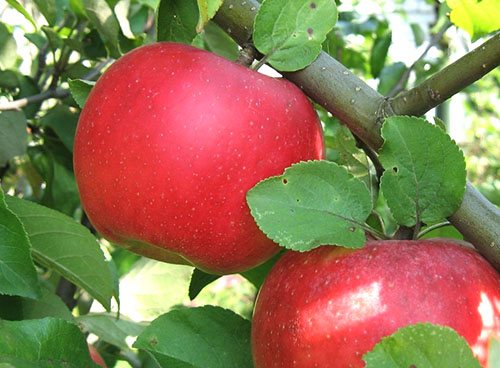

Thanks to the crossing of grafenstein red and Macintosh varieties, Lithuanian breeders have obtained the Auxis apple variety with a compact rounded crown of medium thickening and fruits of autumn ripening.
The flowering of trees of this autumn variety in the apple orchard begins towards the end of May, while the presence of other varieties of apple trees nearby is necessary for pollination of the flowers. As a result, medium-sized fruits are formed, whose weight ranges from 90 to 180 grams. Apples with an oily, smooth skin have an even flattened-rounded shape and a greenish-yellow color, at the stage of removable ripeness, on which a rich carmine or red blush, covering almost the entire surface of the fruit, stands out. Sweet and sour refreshing apples, ripening in mid-September, have dense yellow flesh, which, when stored, does not lose its structure until the end of winter.
The first fruiting of the Auxis apple tree more often occurs 4–5 years after planting. At the same time, the variety in the middle lane shows average winter hardiness and the same resistance to scab. In addition, fruits that are not harvested on time fall off.
Description and photo of an apple-tree variety Osennee Nizrosloe
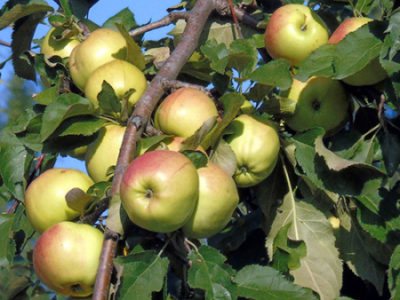

Apples are juicy and sweet fruits that children and adults love to feast on. To date, many varieties have been bred. Some people prefer juicy and sweet fruits, others like fruits with sourness, but, of course, everyone can choose the type that suits his taste.
One of the most popular dwarf apples is the Autumn Low-growing variety.
What if the apple tree bent over?
In the case when, under the influence of strong winds, the apple tree bends in one direction, many people think that it is no longer possible to fix it. But this is not true. What to do to make the tree even again? You need to drive a stake into the ground from the side opposite to the one into which the apple tree bent, gently pull the tree up to it and tie it. You can also put a support on the side into which the apple tree arches.Of course, in one day the tree will not become even, this requires at least three years, after which it will already be possible to remove the support.
Tinning
This is a special type of care that is typical for columnar apple trees. It consists in sowing cereals or all sorts of spices around the trees (lemon balm, dill, which, by the way, can also protect from pests), and then periodically carefully mow them. Such a procedure is necessary for plants because their root system is very close to the surface. It is not pivotal, that is, it does not have a main root extending deep into the soil. Because of this, the roots can easily suffer from external influences on the soil above them. And due to tinning, this possibility is much reduced. In addition, mulching can be used for the same purpose.
Advantages and disadvantages of autumn apples
Many gardeners give preference to autumn varieties, because they have heard about their advantages:
- they perfectly retain their properties (for one to two months if stored in a fruit storage or from two to two and a half months if stored in a refrigerator);
- long fruiting (the period for different species varies from 3 weeks to one and a half months);
- some varieties have excellent taste even when picked unripe or overripe;
- autumn varieties are acclimatized in many regions, so there will be no problems with the selection of the best options for planting;
- autumn apples taste good when eaten fresh and are great for making jam, preserves, dried fruits;
- autumn apples are welcomed by winemakers as they make delicious wine and liqueurs.
DIY apple picker
Gardeners do not find significant shortcomings, except that some varieties are characterized by increased susceptibility to scab.
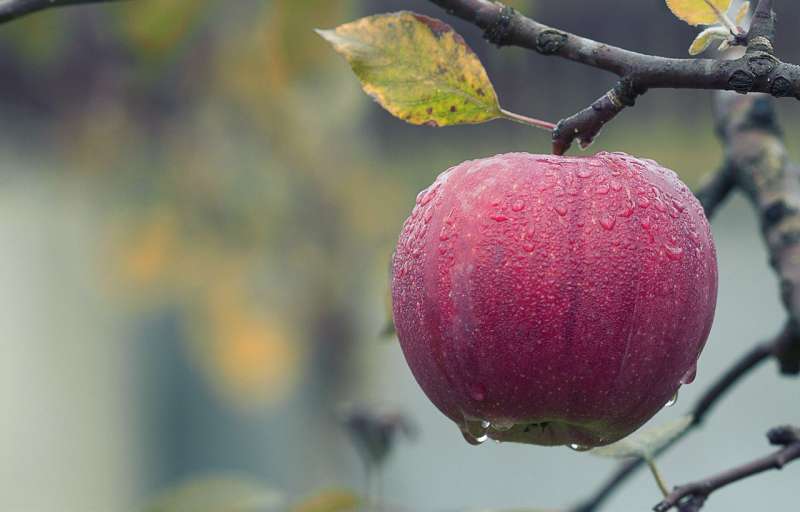

Description of the variety
What species does it belong to?
This is an apple variety that belongs to the autumn species in terms of ripening.
Breeding history
This variety was bred as a result of crossing Skryzhapel and Pepin saffron... IV Michurin was engaged in these works.
Region of natural growth
Autumn Low-growth is a variety that was included in the State Register of Breeding Achievements in the Central Black Earth Region.
additional characteristics
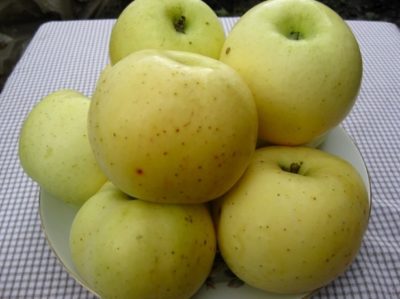

The apples of the variety are medium in size, they are slightly flattened, on their surface there are clearly visible ribs. The rind is smooth, dry and shiny.
The main color is greenish-yellow, although a red blush is present in some places. The underlay is thick and curved.
The pulp is green, its consistency is dense, it is juicy and sweet and sour.
Advantages and disadvantages
The advantages of the variety include:
- high productivity;
- resistance to low temperatures;
- early maturity;
- long-term storage and high transportability.
The disadvantages include the defeat of the scab, the formation of which is influenced by high humidity.
Tree height and crown width
Already from the name it is clear that the height of the tree is insignificant - 1.5-2 m. The crown of the tree is horizontal, its width does not exceed 3 m.
Features of ripening and fruiting
Harvesting takes place at the end of August to September.
Next, you can see the photo of the Autumn Low-growing apple tree:
Site selection
For an apple tree of this variety, it is unacceptable to choose an area with darkening.... You need an open and sunny space.
Soil preparation
For an Autumn Low-growing seedling, it is necessary to choose fertile soil, but at the same time it should not be too acidic. So before planting, the soil can be deoxidized with dolomite flour or lime. You need to bring them in during digging.
Dig the planting holes a month before planting... Its depth should be 0-75 cm, width - 1 m. Fill it with fertile soil and rotted manure (20 liters per tree).Add superphosphate and ash (1 kg each). After filling the hole, a mound should form.
Landing technology
After all the preparatory activities have been completed, you can proceed to direct landing, observing the following action plan:
Further, a useful video on the topic "How to plant an apple tree seedling correctly?":
Irrigate according to weather conditions. If the apple tree has not yet entered into fruiting, then water it 3 times a day. One tree will take 50 liters of water. The last time to humidify is in August.... Apple trees that bear fruit should be watered 3-5 times a year - before flowering, during it and until the ovaries fall off. When a tree grows on sandy loam soil, it will require 40 liters of water.
Apply top dressing in the 2nd and 3rd year of life. To do this, use a liquid complex fertilizer. It takes 30-40 g for one tree. Use the mullein solution 2 times per season. To prepare it, take manure and water in the following ratio - 1:10. One tree takes 10 liters of solution.
Carry out tree pruning according to the following scheme:
Pruning seedlings
In spring, young seedlings need formative and sanitary pruning. Pruning is carried out before the leaves and flowers appear.
- If the seedling has only one branch with many buds, the seedling is shortened at a height of 1 m from the ground... In this case, several full-fledged buds should remain, from which lateral branches will form.
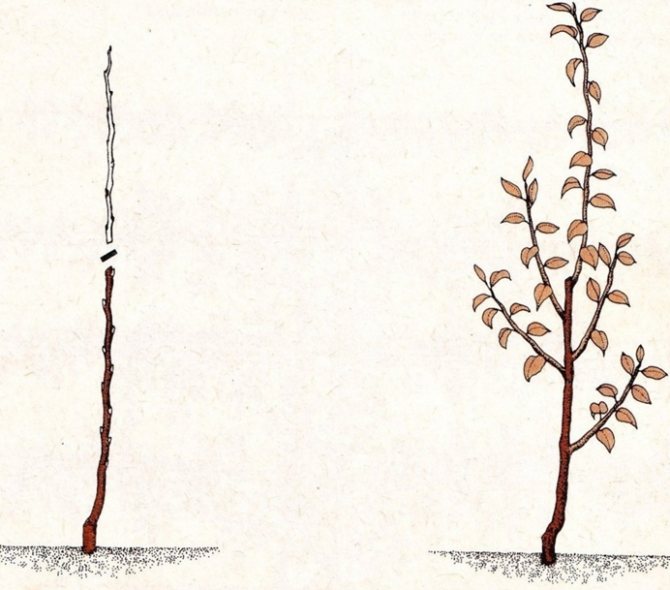

As a result of the initial pruning of the seedling, 4–5 strong shoots are formed by autumn. - If the seedling has branched shoots, they begin to form the crown... Shoots close to the ground (up to 0.5 m) are cut, and the branches above are shortened up to 3 kidneys, while counting is from the base of the branch. Shoots that have grown at an acute angle to the trunk are recommended to be removed completely, and weak and frost-damaged branches are also disposed of. The conductor is shortened taking into account the branches left, it must rise above them by 20 cm.
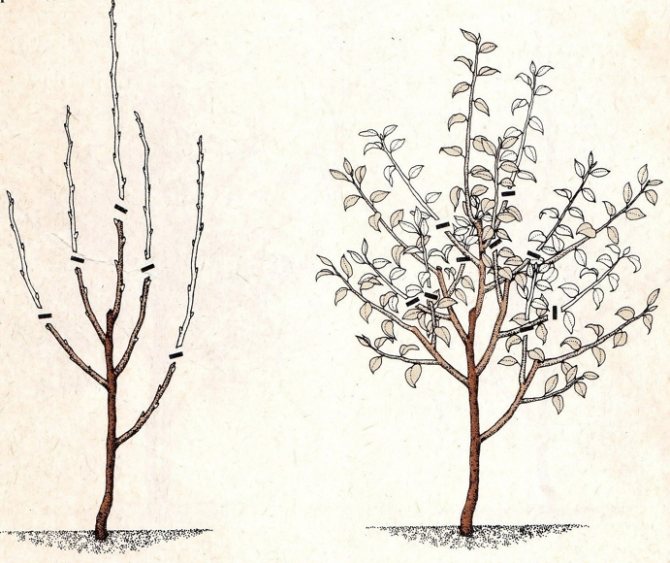

All lateral shoots not needed for the skeleton are cut off. - Sanitary pruning is also performed in autumn.removing broken branches. If the growth of the tree is weak, large branches are not removed, this can worsen the general condition of the tree.
Rating
There are many of them. I will name one option:
- Cinnamon new;
- Auxis;
- Bessemyanka Michurinskaya;
- Zhigulevskoe;
- Young Naturalist;
- Autumn joy;
- Marat Busurin;
- Antonovka gold;
- Saratov saffron;
- Welsey;
- Glory to the winners;
- Mac;
- Zhigulevskoe.
By sweetness
- It is the autumn varieties that are more often used for making juices, jams;
- AND the taste is great... Including sweet;
- And there is time for recycling.
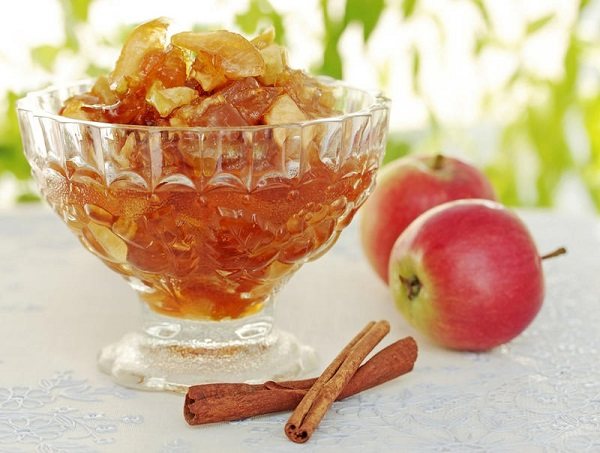

The autumn varieties make a wonderful jam.
For resistance to scab and other diseases
You will have less worries and problems with such a disease if you grow such varieties:
- Zhigulevskoe;
- Cinnamon new;
- Autumn joy;
- The chosen one.
Or maybe they won't be at all?
By yield
- Antonovka six hundred grams - 100-150 kg. From individual - up to 500 kg. But you have to wait 20-25 years;
- Bellefleur-Chinese;
- Borovinka - 300-350 kg per tree;
- The twist is white. Like Anis.
Growing in regions
The most convenient and favorable area for growing is considered to be Central and Central Black Earth. Even where unfavorable conditions periodically occur, the apple tree can be cultivated.
In outskirts of Moscow
For the Moscow region, this hybrid is ideal, fully suitable for growing conditions. Standard care procedures and nothing else is required.
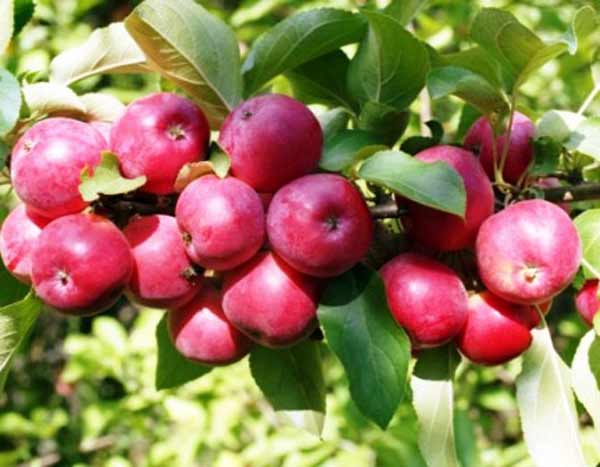

Cultivation of an apple-tree of the Osennyaya Joy variety in the Moscow region.
In Altai
Breeders claim that growing in Altai will not be difficult. The apple tree has the ability to adapt to climate change, so it will be able to bear fruit in Altai. There is only one small caveat: feeding must be regular so that the apple tree can maintain its immunity.
In Siberia
The harsh conditions are not particularly favorable for cultivating the variety. If Autumn Joy is cultivated, it is only on stanza rootstock and subject to good shelter.
Description of the best gardeners varieties with photos and reviews
Below we have collected the varieties most beloved by gardeners, added their description, photo of fruits and reviews.
Autumn striped (Streyfling)
Autumn stripe, Stripe, there are many more different names for this Dutch apple variety. Streifling has been successfully grown in our country for more than half a century, despite the fact that the cultivar is demanding to care for - it is hygrophilous and does not bear fruit every year, the Autumn striped one is considered one of the most delicious September apples and quite lingering.
Features of the apple tree variety:
- the fruits are roundish, pointed downwards, covered with a dense orange-red skin with pale stripes, the flesh is yellow sour, with a wine flavor, the weight of apples is 100–120 g;
- tall - up to 9-10 m;
- drought-resistant;
- frost-resistant;
- the harvest is stored until the end of December.
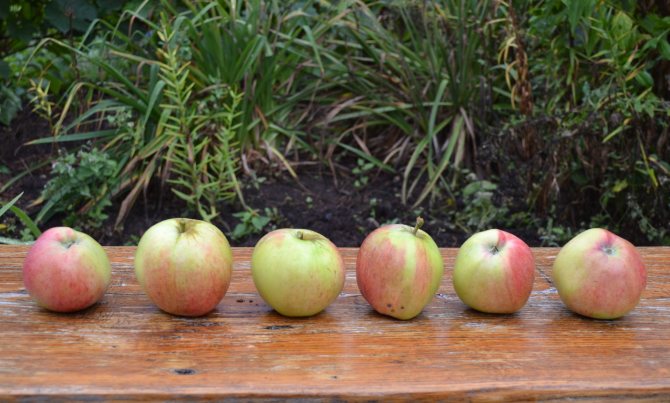

Autumn striped
Streyfling lives with me and bears fruit right in the yard. He is many years old - the garden was planted by the state farm in the 60s of the last century. The appearance of the fruit, like that of other varieties, varies from year to year, probably depending on the weather of the season, but fully corresponds to the pictures and photos in the descriptions. (Vitaly, not my Streyfling in your photos). The apples have a classic slate taste that cannot be confused with another (like Antonovka). The taste probably depends on the SAT, as in hot seasons it is unusually sweet. It is sweet this season too, but after ripening. In cool seasons, apples are sweet and sour and are reluctant to eat.
Anatoly Ts.
Glory to the winners
This variety will soon celebrate its centenary: in 1928, Ukrainian breeders presented us with an apple tree with wonderful scarlet fruits. Their white juicy pulp is suitable for juice, and for mashed potatoes, and in jam, the not very tough skin allows you to feast on fresh, and for a rather long time - the fruiting of the cultivar, like other autumn varieties, is long - more than 2 months you can harvest the crop, first unripe apples , later on the volunteer - it also has a wonderful taste and is even stored for up to 45 days.
Other characteristics of the variety:
- vigorous apple tree - more than 10 m;
- the fruits do not spoil when ripening - the pulp remains juicy and aromatic;
- Slava's high resistance to scab and powdery mildew is noted, sometimes it is affected by fruit rot;
- the yield of one adult tree is 75–100 kg.


Glory to the winners
Glory to the Winners (Peremozhtsy) has been successfully growing for me for 10 years, apples with a harmonious sweet and sour taste, juicy pulp, a distinctive feature when fully ripe, if you shake an apple inside, its seeds rattle like a rattle. Autumn variety.
tepcow1973
Video: apple tree Glory to the winners
Autumn joy
Michurin's hybrid of Cinnamon and Welsey is a worthy answer to overseas apples. Autumn joy is resistant to scab, perfectly tolerates severe winters even in Siberia and the Urals, is not afraid of drought, and the fruits of this cultivar are the standard of autumn apples: reddish, with blurred strokes when fully ripe, the middle is creamy, juicy, with spicy notes, weighs the fruits up to 120-160
Description of the apple tree:
- high - 7-9 m;
- ripening of fruits occurs in mid-August;
- store the crop in a fruit storage for up to 1.5 months;
- a tree over 20 years old is capable of giving up to 150 kg of apples.
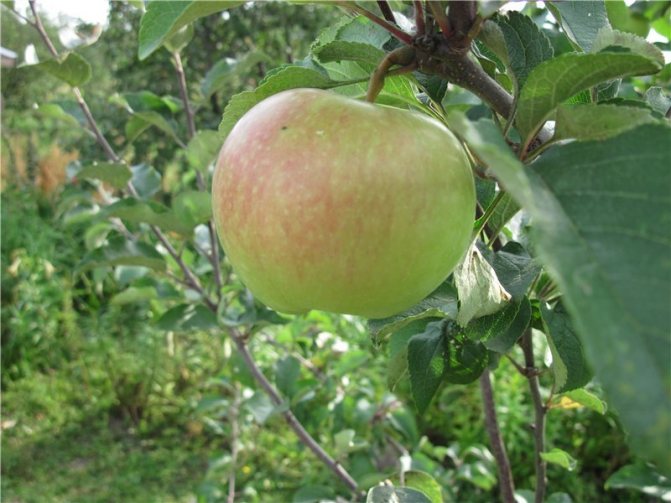

Autumn joy is a great autumn variety
Autumn joy is an excellent cultivar for all occasions. We send the harvest of this apple tree to our brother in St. Petersburg (sometime at the end of September) - the gift arrives at the addressee without a dent, then lies on the balcony for another month. Maybe the apples still lay, but they are usually eaten.
Video: apple tree Autumn joy
Anisovka: Anise striped, Anis scarlet, Anis Sverdlovsky
Anise apple varieties of autumn ripening are loved and appreciated by domestic gardeners.Anise is represented by several cultivars: Anise striped - an early autumn variety with striped apples, Anise scarlet ripens a little later, the fruits are red, slightly flattened, Anis Sverdlovsky - an improved form of Striped, more cold-resistant and productive cultivar.
Features of the apple tree Anise striped:
- vigorous;
- drought-resistant;
- fruits weigh up to 70 g, light pulp crumbles when overripe, becomes dryish;
- high yield - up to 170 kg per tree.
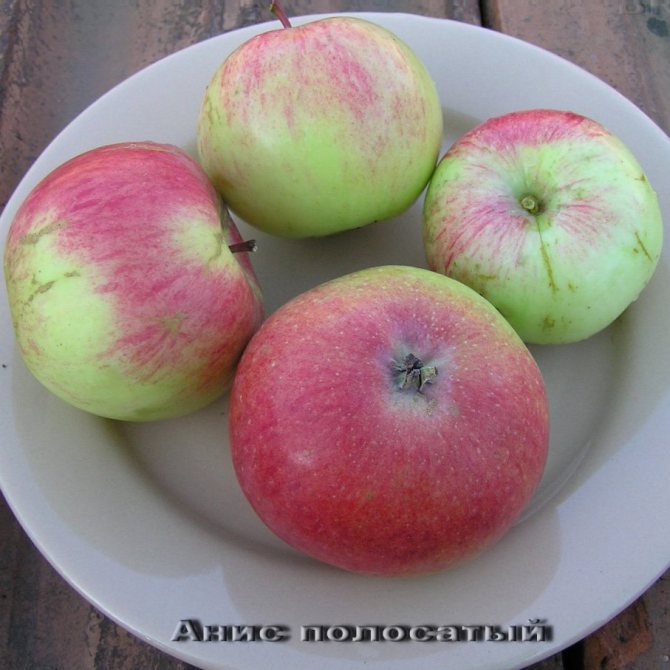

Anise striped or Anisovka - an old variety bred for the Volga region
Description of the Scarlet Anise variety:
- often affected by fruit rot;
- tall;
- winter hardiness is high;
- not afraid of drought and heat;
- fruits are round, red, with blurred strokes, weight 60 g.
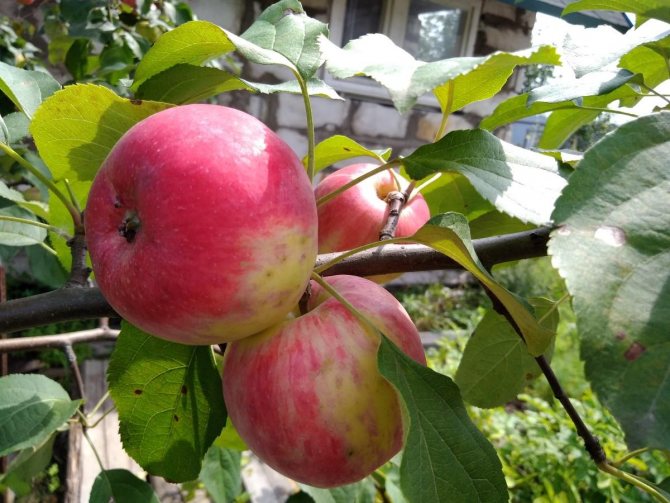

Scarlet anise - "clone" of Anise striped, only with red fruits, the harvest can be tried already in early September
Apple variety Anis Sverdlovsky:
- medium-sized;
- fruits are round, carmine, weight 80–100 g, pulp is light, juicy, fragrant;
- high resistance to most fungal diseases;
- drought-resistant.
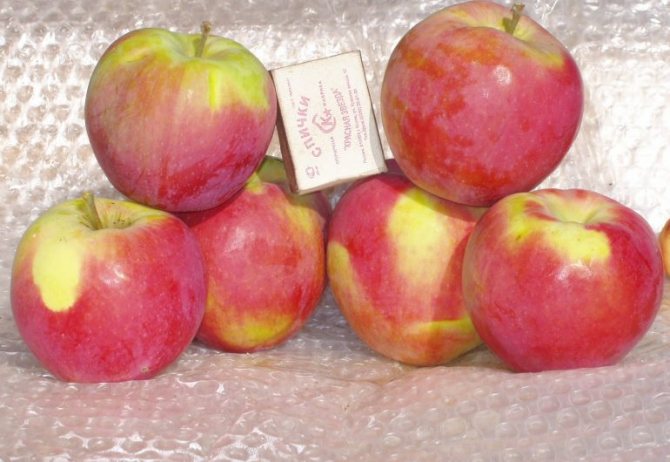

Anis Sverdlovsky fully matures only at the end of September
Mequintosh
A classic autumn apple tree, a favorite of cultivars in almost every corner of our country, Mekintosh is a well-deserved Canadian cultivar. Mekintosh has several advantages:
- according to experts, it bears fruit up to 100 years of age;
- fruits are red-burgundy, round, the middle is light, juicy, sweet, with a candy flavor, weighs up to 200 g;
- highly winter-hardy;
- rarely suffers from fruit rot;
- transfers transportation without loss of quality properties;
- the height of the tree is 6–8 m.
The disadvantages include high sensitivity to scab and non-simultaneous ripening of fruits.
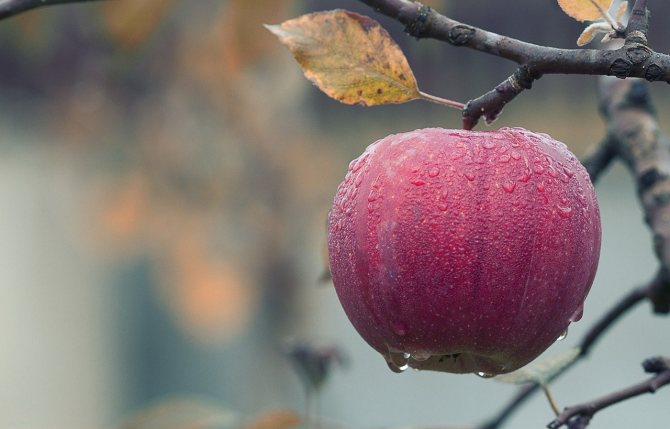

Fragrant Mekintosh apples are familiar not only to gardeners, they are a common variety that is often grown for sale.
For me personally, Macintosh is the standard of taste, despite its shortcomings (tendency to disease, short shelf life, etc.). And Lobo, Spartan, and Cortland, in my opinion, do not have that unique aroma of the original variety and have their own shortcomings. For example: Spartan lasts longer, but less juicy, harder rind and smaller at the slightest error in pruning. Cortland is inferior to Macintosh in yield. Lobo loses its taste during storage. And with all this, everyone's disease resistance is about the level of the Macintosh and, as for me, they do not reach Macintosh in taste. It resembles Macintosh Melba more than others, but it is a summer variety. I have no mantet in my collection, so I can't say anything about him.
Drongo
Video: Mekintosh apple tree (Macintosh)
Mekintosh or Macintosh - as everyone around them calls it - is wonderful in that you can eat its apples already in August - the dark green fruits with a burgundy bloom are juicy, hard, they get delicious juice (sweet, sugar can not be put), we make fruit salads, just enjoy the yummy. And in September - Macintosh goes differently: we pick scarlet apples with a whitish wax coating and collect them for filling in pies, for jam, we do drying - by this time the fruits are even sweeter and more fragrant. What will remain on the tree by October - in the basement on the steps, the carrion - home and neighbors - everyone is delighted.
Winter saffron
A Siberian with a rather docile character - Winter saffron - is considered by many to be a winter variety of apples, possibly due to its impeccable keeping quality - up to 150 days. But in the State Register it is marked as autumn. Saffron fruits are round, orangeish, weighing no more than 50-60 g, the flesh is dense, fine-grained, rather aromatic.
Features of the variety:
- medium-sized;
- scab resistant;
- in frosty winters it can freeze slightly.


Winter saffron is the best!
Saffron is winter, many refer to winter - (also called rusty Antonovka) large brownish-red apples, the peel is rough, rough. The pulp is white, coarse-grained. When unripe (on the tree) it is brown in color. After collection, they turn red. They are also very tasty apples.Stored in the same way as Antonovka.
Theme
Cinnamon striped
The old variety Brown or Cinnamon striped is the result of Levshin's work, the cultivar appeared in the 19th century, later more than 15 varieties were created, derived from Cinnamon striped. This is an exceptionally winter-hardy variety - it easily winters at -35–37 degrees.
Features of the variety:
- medium height - 6–8 m;
- fruits are round, with orange-burgundy blurred lines on the sides, refreshing pulp, with cinnamon notes, creamy, loose, fragrant, weight 110–150 g;
- ripens at the end of October.
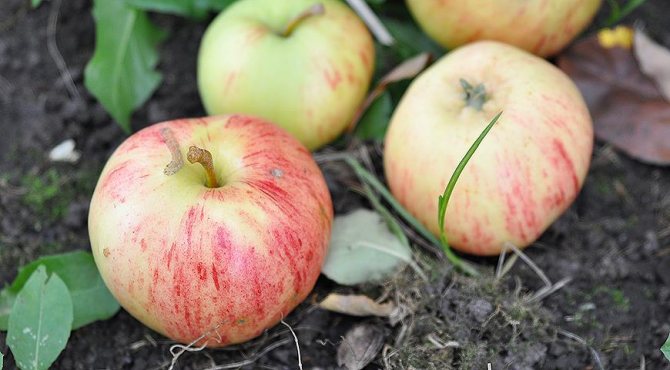

Late autumn variety Cinnamon striped is appreciated for the high keeping quality of fruits.
Cinnamon striped is one of the most proven old varieties. And the scent ... um, you can't confuse it with anything. One of my favorite apples. A couple of apples lie in the country at +18, and do not rot, dries like processed imported ones, no chemistry was used. The rest are all already eaten. One thing is bad, it is a pity that it is not stored all winter ...
Numa
Flashlight
Agrarians of the northern regions are happy to grow the Lantern variety - the brainchild of Krasnoyarsk breeders belongs to cold-resistant, unpretentious cultivars with stable immunity to many diseases of pome fruits. This apple tree is self-sterile, so it is not grown alone, but in the presence of pollinating trees and with proper agricultural technology, the Flashlight will become a favorite apple tree in your garden.
Description of the Flashlight variety:
- medium-sized apple tree;
- fruits do not crumble;
- tolerate transportation well;
- small apples - 40-50 g each, raspberry-purple, with yellowish pulp, slightly sour.
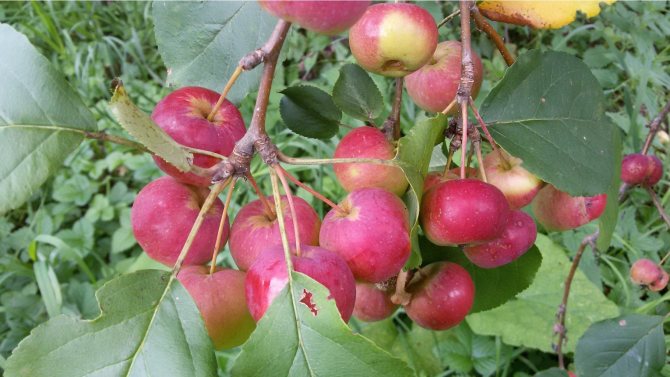

The flashlight enters fruiting in the 4th year
The "Flashlight" variety is very good, none of the other produces such tasty, with a characteristic sourness and aromatic compotes, preserves and jams, as from this one.
val5591
September red
It is a modern early autumn variety for regions with mild climates. September red perfectly bears fruit in the Crimea and Krasnodar Territory, rarely gets sick and does not suffer from hot weather.
Description of the variety:
- medium-sized;
- fruits are round, yellowish-red, flesh is white, sweet, with a banana flavor, weight 210 g;
- shelf life up to 80 days.
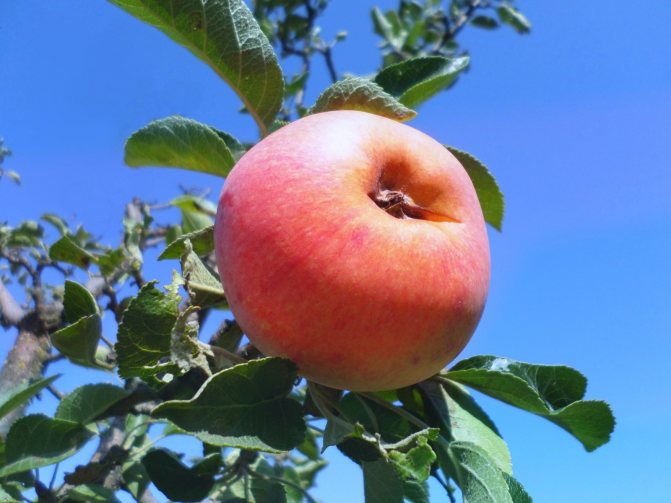

September red belongs to dessert varieties
Welsey
American Welsey was zoned on the territory of our country in the middle of the last century. The cultivar is appreciated for its scab resistance and relatively good winter hardiness.
Other characteristics of Welsey:
- medium height - up to 4.5 m;
- yield within 200 kg per tree;
- bears fruit in September - October.
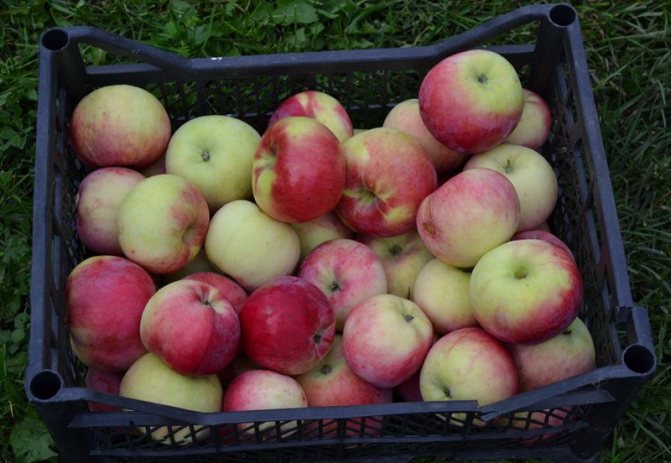

Wellsie is characterized by a blush on one side - still completely unripe fruits are always slightly "tinted", weighing 120–160 g each
In our country, Welsey in favorable years for the development of fungal diseases is affected by scab, this year the defeat was in a weak degree. Therefore, in the fall, we try to process the apple trees with urea. The apples are delicious, stored in our conditions until February. There is a Welsey clone in the garden with a worse taste, but it is stored for a month longer. Trees over 25 years old, tall, periodic fruiting.
ALEK
Sinap Minusinskiy
Siberian experts consider Sinap Minusinsky to be absolutely unpretentious and weather-resistant cultivar. Agrarians appreciate the Variety for its high productivity and excellent transportability of fruits.
Features of the variety:
- medium-sized;
- average winter hardiness;
- fruits are small - up to 40 g, orange, with purple strokes, the pulp is juicy, with spicy notes.
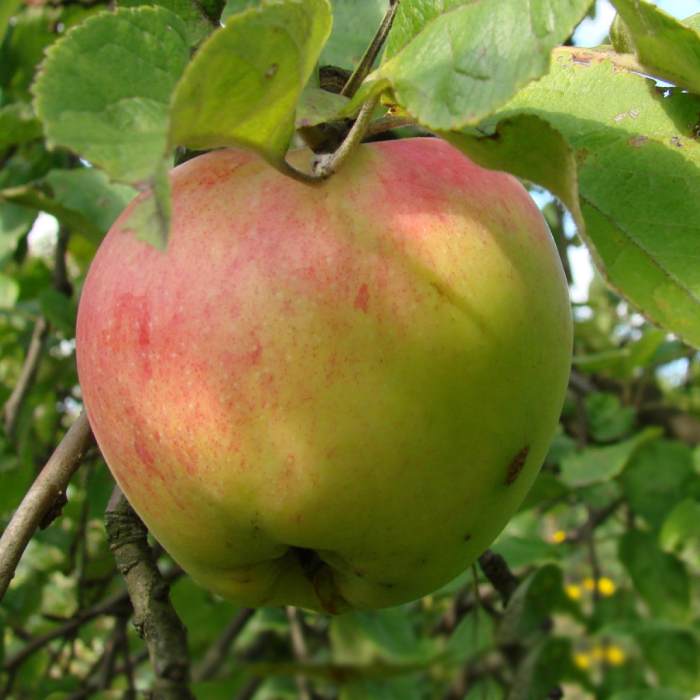

Sinap Minusinsky is the most delicious apple in the fall!
Rossoshskoe august
In the Chernozem region, Rossoshskoye August is often called a summer variety, but in the State Register this apple tree is classified as an early autumn cultivar. The crop ripens in early September, it can lie down for up to 50 days in a cool room. Cultivar apples are loved for their dense, juicy pulp - they are so good for juice and jam.
Other features of the variety:
- medium-sized tree - up to 6–7 m;
- rarely affected by scab and fruit rot;
- fruits are round, regular, orangeish, with light green “tan”, light, aromatic flesh, weight 130–160 g;
- drought-resistant.
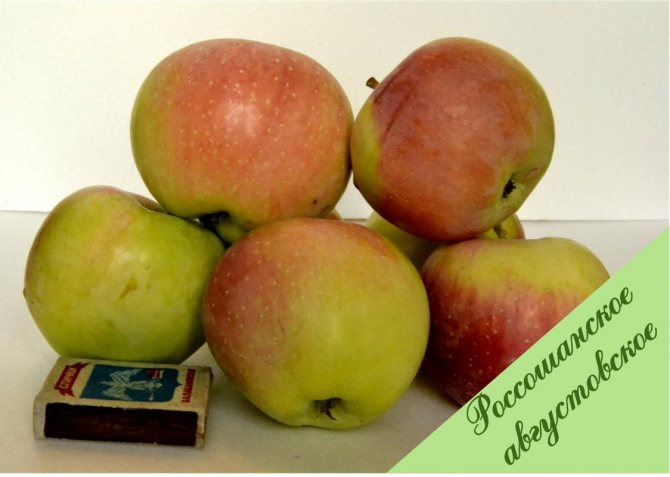

Rossoshskoye August produces consistently
Rossoshanskie varieties are “golden” in terms of quality characteristics, tasty, but suffer from scab and in most cases are either not hardy or of medium hardiness. They are mainly for the south of the Black Earth Region, where they show sufficient winter hardiness and reveal their taste.
Fall
Ural bulk
Variety experts will not argue that the taste of the Ural bulk liquid is mediocre, but the ability to yield crops even in a cool, damp summer is an important advantage of the cultivar.... The Ural liquor is not afraid of return frosts, and the taste of fruits with sourness is very useful for juices and the preparation of dried fruits.
Description of the Ural bulk:
- medium height - up to 7 m;
- annual fruiting;
- moderately resistant to many diseases of this culture.
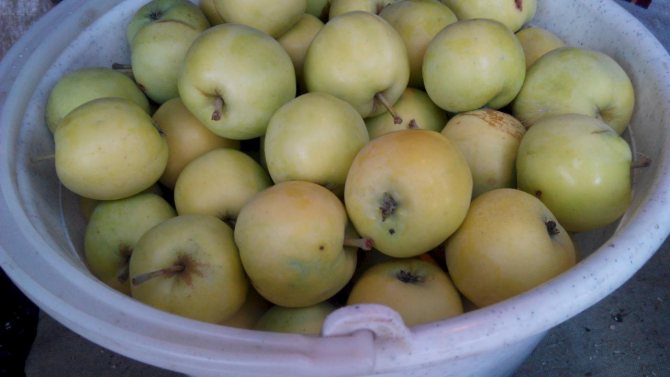

The taste of Ural bulk apples is closer to sweet, with a barely perceptible sourness, for which the variety was appreciated by patients of gastroenterologists
Ural Bulk has a size of 3-4 cm in diameter. Winter hardiness is very high, it ripens in Moscow in September. I don't think the conditions in Kamchatka will be inappropriate for him.
Andrey Vasiliev

